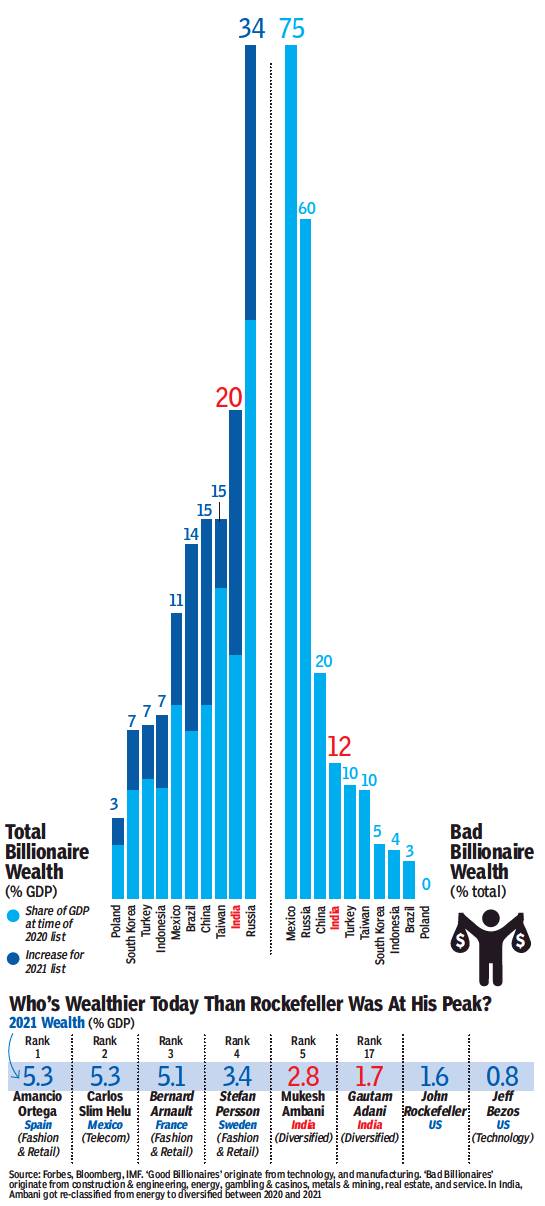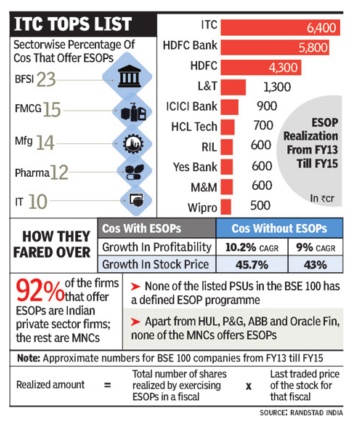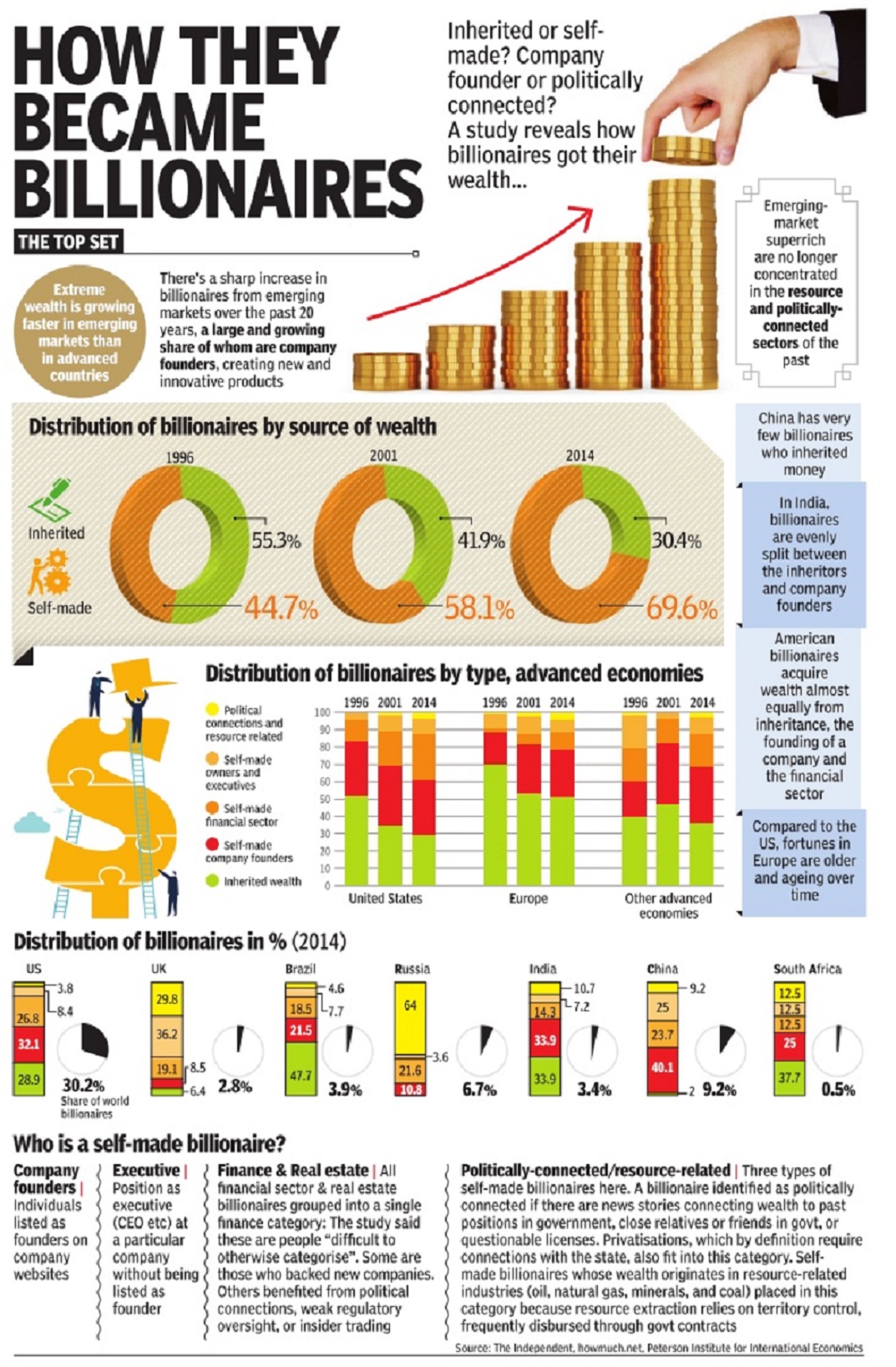Rich List: India
See also the Rich Lists of individual years
Rich List: India <> Rich List: India, 2014: Forbes <>Rich List: India, 2014: Hurun <>Rich List: India, 2015: Forbes <> Rich List: India, 2015: Hurun <>Rich list, India: 2016 <> Rich List: India, 2016: Forbes <> Rich List: India, 2017 <> Rich List: India, 2017: Hurun<> Rich list, India: 2018<> Rich list, India: 2019<> Rich List, India: 2020<> Rich List, India: 2021<> Rich List, India: 2022
Rich list of film artistes: India

This is a collection of articles archived for the excellence of their content. |
TRENDS, ANALYSES
History
Akbar among the world’s 10 richest ever?
10 richest men in history, January 12, 2018: The Times of India
HIGHLIGHTS
There is an Indian emperor who features among the 10 richest persons of all time
A study revealed that the ruler had 25 per cent of the global GDP in his possession
On January 10, India's richest person Mukesh Ambani was ranked 20th in the list of wealthiest people in the Bloomberg's Billionaires Index. Ambani with his $41.2 billion wealth ranking at No. 20 is of course, no mean feat. But picture this-- there was an Indian emperor, long before our time, who actually features among 10 richest persons of all time.
Money magazine in 2015 compiled a list of richest people of all time by taking an individual's wealth and comparing it to the country's GDP, apart from adjusting for inflation and speaking to hundreds of economists and historians. The study revealed that Emperor Akbar, the third of the Mughal rulers, had 25 per cent of the global GDP in his possession.
In the run up to the budget as the government is focusing on expanding the tax base, finance minister Arun Jaitley can take a few lessons from Akbar as the research describes the Mughal dynasty as one of the most effective empires of all time at extracting wealth from the population. For all those who may sense tyranny, the study also speculates that India's GDP per capita under Akbar was comparable to Elizabethan England.
While it may be a controversial affair to compare the riches across different eras, the research does throw up some really interesting findings. For example, the crown of the 'richest of all time' goes to King Mansa Musa, whose wealth the Money magazine puts as 'too rich to describe'. Musa was the ruler of the ancient city of Timbuktu (in modern day Mali), which used to be the world's largest producer of gold.
Talking of ancient times, the Roman empire of course can't be ignored. Its founder Augustus Caesar was the second richest man of all time. Augustus, whose wealth has been projected at $4.6 trillion is said to have "personally owned all of Egypt". Caesar is also the only ancient ruler (he was in fact born in the BC or Before Christ era) in a list dominated by medieval kings. Apart from Akbar and Musa, the research lists contemporaries like Emperor Shenzong, Genghis Khan and Alan the Red.
However, there are a few entries from modern history like Joseph Stalin and John D Rockefeller. But just as no list of batting records is incomplete without Sir Don Bradman, this hall of fame of rich folks mentions Microsoft founder Bill Gates as the 9th richest since the beginning of time. That though might come in for contention as the Bloomberg's Billionaires Index mentioned above has revealed that Amazon founder Jeff Bezos is worth more than Gates ever was.
Nizam of Hyderabad, 1886-1967
October 16, 2012: The Times of India Hyderabad's last Nizam named all-time richest Indian
The last Nizam of Hyderabad was born in 1886 and ruled Hyderabad till 1947. He continued to be India’s richest man till his death in 1967 (and his heirs till around 1970).
Osman Ali Khan died in 1967 at age of 80.
Mansa Musa I of Mali ? the obscure 14th century African king - was named the richest person in all history, British newspaper 'The Independent' reported today.
With an inflation adjusted fortune of $400 billion, Mansa Musa I would have been considerably richer than the world's current richest man, Carlos Slim, who ranks in 22nd place with a relatively paltry $68 billion.
The list, compiled by the Celebrity Net Worth website, ranks the world's 24 richest people of all time. The list advertises itself as the top 25, but only 24 names appear in the list.
Although the list spans 1,000 years, some aspects of wealth appear consistent throughout history; there are no women on the list, only three members are alive today, and 14 of the top 25 are American.
The list uses the annual 2199.6 per cent rate of inflation to adjust historic fortunes? a formula that means $100 million in 1913 would be equal to $2.299.63 billion today.
Mansa Musa I ruled West Africa's Malian Empire in the early 1300s, making his fortune by exploiting his country's salt and gold production. Second on the list are the Rothschild family, whose descendants are still among the richest people on the planet.
Starting out in banking in the late 18th Century, Mayer Amschel Rothschild's finance house accumulated a total wealth of $350 billion.
Meanwhile, John D Rockefeller, third on the list, is the richest American to have ever lived, worth $340 billion in today's US dollar at the time of his death in 1937.
In comparison, the poorest man on the list is 82-year-old Warren Buffett, who at his peak net worth, before he started giving his fortune to charity, was $64 billion.
2017, Forbes
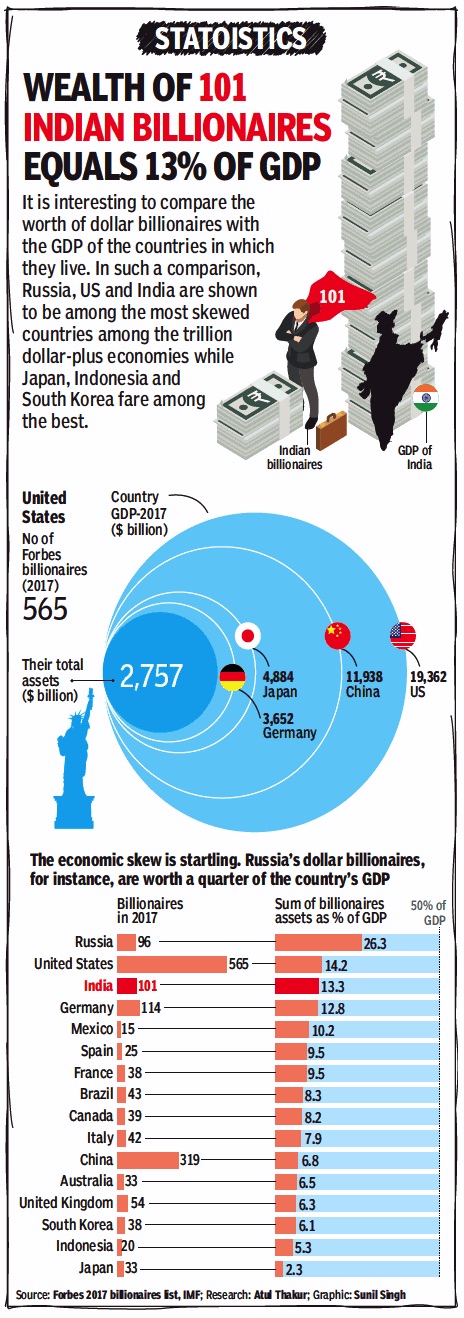
From November 20, 2017: The Times of India
See graphic:
The percentage of the economies of India, China and other major countries, owned by the billionaires of these countries, in 2017.
2017: India’s 2 lakh super-rich worth BSE m-cap of ₹153L cr
February 14, 2018: The Times of India
The number of super-rich households in India has grown 12% to nearly 2 lakh in 2017, while their collective net worth grew 5% at Rs 153 lakh crore, nearly equivalent to the market capitalisation of all the companies listed on the BSE, a study of ultra high-net worth individuals (ultra HNIs) in the country noted.
The number of ultra HNIs is expected to more than double to over 3 lakh in five years while the total wealth would also jump more than twofold to Rs 352 lakh crore, the study by Kotak Wealth Management said. It estimated the numbers after taking a minimum net worth of Rs 25 crore as the hurdle rate.
The study had global consultancy major EY was a collaborator. It used data points like India’s GDP growth, savings rate, investments in asset classes like stocks, mutual funds, real estate, gold, bank deposit growth, etc, to estimate the numbers. Titled ‘Top of the Pyramid 2017’, it’s the seventh edition of this annual publication.Interestingly, the study noted that Indians were getting wealthier at a younger age. “About 60% of ultra HNIs surveyed for the report are below 40 years as against 47% interviewed in the earlier edition,” the report noted. Emergence of a large number of this crowd of young super-rich is due to family inheritance, said Jaideep Hansraj, CEO, Kotak Wealth Management & Priority Banking.
Speaking about the current market trend, Hansraj expected investors would prefer to move their investments into debt-market products, as equity markets were “crazy” since the past fortnight.
Talking about investors’ preference for physical assets, Hansraj said that he did not expect investors to return to park their money in gold and real estate. However, investors’ preference for financial assets, which was boosted by the demonetisation in November 2016, would continue, he added.
Ruchir Sharma’s good and billionaires, inequality…: 2021
Billionaire Boom: How Covid cash ended up in the wallets of the rich / The Times of India
Excerpts
Billionaire Boom: How Covid cash ended up in the wallets of the rich
Easy money pouring out of central banks is a key driver behind this surge in fortunes, and the resulting wealth inequality
Ruchir Sharma
In recent decades, the global population of billionaires rose more than fivefold... Rising inequality was threatening to provoke popular backlashes against capitalism itself.
The pandemic has reinforced this trend.
The billionaire population boomed
On the 2021 Forbes list, … India added 38 for a total of 140, and has surpassed Russia for the third largest population of billionaires in the world.
Although India is relatively poor, billionaire wealth equaled more than 17% of gross domestic product, one of the highest shares in the world, with most of the gains accruing to families in industries prone to crony capitalism.
I distinguish “good” from “bad” billionaire elites by calculating the share of their wealth that comes from generally clean, productive industries — particularly technology and manufacturing — as opposed to industries such as real estate or oil. No doubt, this miscasts many oil or real estate tycoons. But in general those industries are less productive, more prone to corruption, and thus the sight of too many billionaires rising in those fields is more likely to incite populist backlashes.
US: WEALTH IS 20% OF GDP
In contrast to India, America’s billionaire class looked surprisingly well balanced in the early 2010s. Billionaire wealth totalled about 10% of GDP at that time, which was in line with the average for wealthy countries. More importantly, relatively few of the leading US tycoons got their start by inheriting fortunes, or built their wealth in “bad” industries.
By 2015, ,,, billionaire wealth mushroomed again to nearly 20% of GDP.
China [in 2020 ] its billionaire class … nearly doubled as a share of GDP to 15%.
Among the 10 top emerging economies on my list, China is in a virtual tie with Taiwan and South Korea for the leading share of billionaire wealth that comes from “good” industries, at a bit more than 40%.
Only in periods of extreme inequality, such as the robber baron age of the early 20th century, were magnates such as John D Rockefeller targeted as public enemies
There are, however, at least 17 real Rockefellers, from Sweden and France to Russia and India. (See chart) Mukesh Ambani saw his net worth more than double last year to $85 billion, and now ranks fifth on the Rockefeller list with total wealth equal to 2.8 % of India’s GDP; Gautam Adani ranks 17th, with total wealth equal to 1.7% of GDP.
INDIA: MORE TOP-HEAVY
India is also a society at risk. The total wealth of its billionaire class equals nearly 20% of GDP, the second most bloated among emerging nations, after Russia. More than 55% of billionaire wealth is concentrated in family fortunes, second worst after Indonesia. The only good news is that bad billionaire wealth declined as a share of the total last year, as new wealth came in industries such as tech, manufacturing and, particularly, in diversified conglomerates. On the whole, however, the general portrait of a top-heavy elite, perpetuated by inheritance, has not changed radically since I started tracking the billionaires list in India.
The pandemic accelerated many economic and social trends that were already in motion, including the billionaire boom, and the threat of anti-wealth backlashes.
Billionaires’ wealth
2023-2024: vis-à-vis the previous ten years
Dec 9, 2024: The Times of India
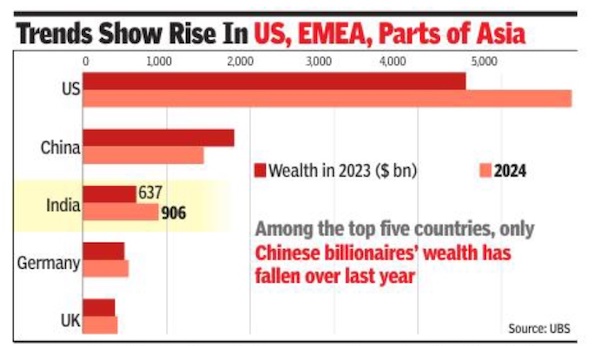
From: Dec 9, 2024: The Times of India
Mumbai : The wealth of Indian billionaires surged 42% to over $905 billion during the last financial year, positioning it as the third largest base behind the US and China, a report by Swiss bank UBS said. In contrast, in China, where the Xi Jinping regime has gone after businesses, billionaires saw an erosion in their net worth.
The UBS Billionaire Ambitions Report said during the last 10 years, the number of Indian billionaires more than doubled to 185, with their combined wealth trebled (rose 263%) at the end of April 2024. Family-led businesses are playing a pivotal role in India’s economic rise. As India breaks into the top tier of global economies, it boasts one of the highest numbers of publicly-listed family-owned businesses, many spanning generations, the report said. This phenomenon has contributed significantly to the surge in Indian billionaires over the past decade.
Rise of billionaire entrepreneurs next decade: Report
Family businesses are spread across a diverse range of sectors — from established conglomerates to new-economy ventures in pharmaceuticals, education technology, financial technology, and food delivery.
While global billionaire wealth growth has slowed, India remains an exception. This is attributed to the continued dynamism of Indian entrepreneurs and the country’s favourable economic environment.
“It’s been a time of exceptional economic growth. During two completed terms in office, Prime Minister Na- rendra Modi’s National Democratic Alliance govt introduced structural reforms that have helped propel the economy to the fifth biggest in the world,” the report said.
This trend is expected to continue, fuelled by rising urbanisation, digitalisation, a growing manufacturing sector, and the ongoing energy transition. India could witness an explosion in billionaire entrepreneurs over the next decade, mirroring China’s trajectory until 2020. In recent years, there has also been debate in the country over growing economic disparity between the rich and the poor.
Between 2015 and 2024, global billionaire wealth surged by 121% to $14 trillion, outpacing the 73% gain in the MSCI AC World Index. The number of billionaires grew from 1,757 to 2,682, peaking at 2,686 in 2021. However, growth has stalled since 2020, with a 1% annual increase in billionaire wealth globally, down from a 10% rate between 2015 and 2020. Regional trends show continued expansion in the US, EMEA, and parts of Asia, particularly India, even as Chinese billionaire wealth fell 16% from its 2020 peak of $2.1 trillion.
Tech billionaires have led the wealth accumulation, tripling their holdings from $788.9 billion in 2015 to $2.4 trillion in 2024, driven by advancements in generative AI, cybersecurity, fintech, and robotics. Industrials billionaires followed, with wealth rising from $480.4 billion to $1.3 trillion due to investments in green technology and reshoring initiatives. In contrast, real estate billionaires lagged, impacted by China’s property correction, the pandemic’s effects on commercial real estate, and rising interest rates in the US and Europe.
Caste, state, religion and the Rich List
As in 2011
Aakar Patel, The peculiar pedigree of the business class, LiveMint, 14 Apr 2011
Forbes magazine has put out a list of the world’s 1,210 billionaires. Fifty-five of them are Indians. A billion dollars is ₹ 4,480 crore. A Baniya is a member of the Vaish caste, originating mainly from Rajasthan and Gujarat.
They are under 1% of India’s population.
[The top 10] Score: Baniyas 8, Rest of India 2. If we consider the Gujaratis Godrej and Premji (from the Lohana caste) as coming from mercantile communities then actually Rest of India wasn’t playing this match so far.
India’s 11th richest man is K.P. Singh of DLF ($7.3 billion). He is the first departure from our trend of mercantile castes. Singh is a peasant [Jaat actually: a community of rural elites and of some Kings: Indpaedia], the most populous caste grouping of India, about 50% of our population [Not really: the Jaats are an elite caste: Indpaedia].
From numbers 11 to 20, there are four Baniyas. They are Anil Agarwal of Vedanta ($6.4 billion), Dilip Shanghvi of Sun Pharma ($6.1 billion), Uday Kotak ($3.2 billion), and Subhash Chandra Goel of Zee, ($2.9 billion). The non-Baniyas are Shiv Nadar of HCL ($5.6 billion), Malvinder and Shivinder Singh of Ranbaxy ($4.1 billion), Kalanithi Maran of Sun TV ($3.5 billion), Mukesh Jagtiani of Landmark ($3 billion) and Pankaj Patel of Cadila ($2.6 billion).
Between 21 and 30, there are five Baniyas. They are Indu Jain of The Times of India ($2.6 billion), Desh Bandhu Gupta of Lupin ($2.1 billion), Sudhir and Samir Mehta of Torrent ($2 billion), Aloke Lohia of Indorama ($2 billion) and Venugopal Dhoot of Videocon ($1.9 billion). The five non-Baniyas are G.M. Rao of GMR ($2.6 billion), Cyrus Poonawalla of the Serum Institute ($2.3 billion), Mumbai builder Rajan Raheja ($2.2 billion), Narayana Murthy ($2 billion) and Gautam Thapar of Avantha ($2 billion). Of the non-Baniyas, three are from mercantile communities: Poonawalla (Parsi), Raheja (Shikarpuri Sindhi) and Thapar (Khatri). Murthy is Brahmin.
Between 31 and 40 are two Baniyas: Rahul Bajaj ($1.6 billion) and Ajay Piramal ($1.4 billion). The non-Baniyas include three Brahmins: Nandan Nilekani ($1.8 billion) and S. Gopalakrishnan ($1.6 billion) of Infosys, and Vijay Mallya ($1.4 billion). Three of the others are from mercantile castes: Chandru Raheja ($1.9 billion), Brijmohan Lall Munjal of Hero Motors ($1.5 billion) and Vikas Oberoi ($1.4 billion). The last two are K. Anji Reddy ($1.5 billion) (from Andhra’s dominant peasant community) and Ajay Kalsi of Indus Gas ($1.7 billion).
Between 41 and 50 are five Baniyas. They are R.P. Goenka ($1.3 billion), Rakesh Jhunjhunwala ($1.2 billion), Brij Bhushan Singhal ($1.2 billion), B.K. Modi ($1.1 billion) and Mumbai builder Mangal Prabhat Lodha ($1.1 billion). The non-Baniyas are Baba Kalyani of Bharat Forge ($1.3 billion), Keshub Mahindra ($1.2 billion), K. Dinesh ($1.2 billion) and S.D. Shibulal ($1.1 billion) of Infosys, and Yusuf Hamied of Cipla ($1.1 billion).
The last five, from 51 to 55, include two Baniyas: Mumbai builder Mofatraj Munot of Kalpataru ($1 billion) and Ashwin Dani of Asian Paints ($1 billion). Two of the others are from mercantile castes: Parsi Anu Aga of Thermax ($1 billion) and Khatri Harindarpal Banga of Noble ($1 billion). Delhi builder Ramesh Chandra of Unitech ($1 billion) ends our list of Indians with a billion dollars or more.
The list has three Parsis, two Muslims and Sikhs in one spot (shared by the Ranbaxy Singhs). Banga is also a Sikh name but Harindarpal is clean-shaven. All of them, except Poonawalla, have inherited their wealth, though in the case of one (Premji), he took a small firm and made it global. There is nobody from the scheduled tribes or castes.
India’s large peasant castes have some representation (Singh, Patel, Reddy), but not much.
There are 26 Baniyas on our list. Many of them inherited their wealth, but just as many (Mittal, Ruias, Adani, Dhoot among others) are self-made.
The list has 16 Rajasthanis, and 13 Gujaratis. Every single Rajasthani is from one caste, Vaish, though they are from two faiths: Hindu and Jain.
Only Gujarat is capable of producing billionaires drawn from four different faiths—Hindu, Parsi, Jain and Muslim—and three different castes: Baniya, Khatri and peasant. This is unique in India and there is something about this secular mercantile culture that produces great men across communities. What is it? Three out of the four biggest leaders of the subcontinent under British rule were Gujarati, and they were drawn from these three castes: Gandhi, Jinnah and Patel. Only 5% of India’s population, Gujaratis don’t have the numbers to dominate its democratic politics. But businesses are not run in democratic fashion. And to rise, you need quality, not quantity.
The heartland of India, where our quantity resides, is missing from this list. Bihar, Bengal, Madhya Pradesh, Odisha, Uttar Pradesh have little or no representation and this does not surprise us.
On the list are 10 south Indians, in proportion to their 20% share of India’s population. The famous five from Infosys are obviously self-made. Of the others, four are first-generation wealthy. This is a good indicator for the future, and it restores some balance in favour of Rest of India.
Two final observations. India’s greatest businessman is not on this list. Why is that? It is because Ratan Tata owns less than 1% of Tata Sons. He is exceptional in every way.
Lastly, how many Baniyas in our top 20 attended the Buffett-Gates meeting to consider giving part of their wealth to philanthropy? Zero.
Aakar Patel is a director with Hill Road Media.
Cities with the most wealth
See Cities of India: the best and the worst> Economic performance
The migration of millionaires
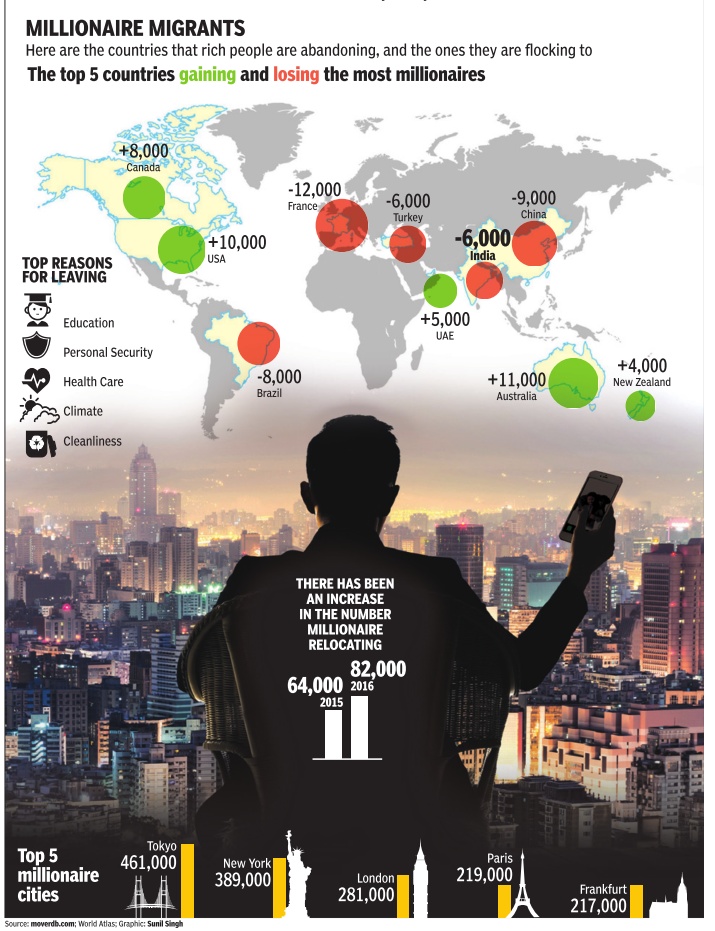
See graphic :
Top 5 countries gaining and losing the most millionaires
2018
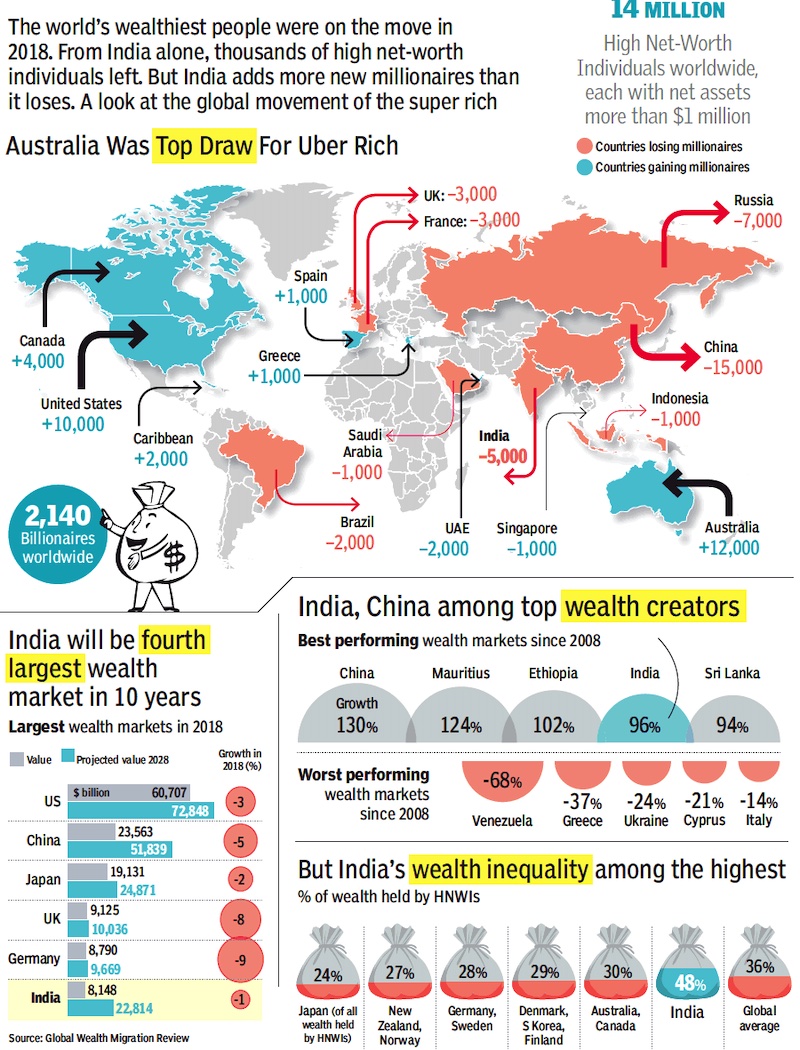
From: May 10, 2019: The Times of India
See graphic, 2018:
The top countries that gained or lost the most millionaires;
The best and worst performing wealth markets, 2008-18,
The largest wealth markets, 2018,
Wealth inequality
2019
Lubna Kably , February 13, 2021: The Times of India
‘Indian rich top world in looking to leave country’
Mumbai:
The Covid may have put international travel plans on the backburner but it has not stopped high net-worth individuals (HNWIs) from shopping for new countries to set up base in — either as long-term residents or citizens.
In 2020, wealthy Indians again topped the list of those making enquiries for ‘residence-by-investment’ or ‘citizenship-by-investment’ programmes. The number of enquiries rose from 2019, said a facilitating agency. Since India does not permit dual citizenship, opting for ‘citizenshipby-investment’ means giving up one’s Indian passport.
The combination of Covid and political turmoil saw the US, in sixth place in 2019, shoot up to the second slot.
About 7,000 wealthy Indians left country in 2019, says report
The third, fourth and fifth spots in terms of enquiries made were taken up by Pakistanis, South Africans and Nigerians, respectively. These details were shared with TOI by Henley & Partners, a global firm engaged in residence and citizenship planning.
As per ‘Global Wealth Migration Review’, issued by New World Wealth, a wealth intelligence firm, Indians were the second largest contingent among the millionaire category to move overseas. Nearly 7,000 wealthy Indians (comprising 2% of the HNWIs) left the country during 2019. It appears that the interest is not waning. “We saw a 62.6% increase in the number of enquiries received from Indians in 2020 as compared to 2019. The base for 2019 was over 1,500 enquiries,” Nirbhay Handa, director and head of global South Asia team, Henley & Partners, told TOI.
Investment-linked migration programmes do not come cheap, but for many, it is much more than just owning a luxury home in an exotic location. It could also mean spreading family assets across several jurisdictions or obtaining better access to a region — say European Union. As per Henley & Partners, the top investment-linked residence and citizenship programmes that Indians enquired about in 2020 were Canada Residency, Portugal Residency, Austria Residency and Austria’s Citizenship programme, Malta Citizenship and Turkey Citizenship. Historically, US, Canada, UK and Australia have been favourites among Indians. “Canada and Australia are key contenders, (but) the processing time for these programmes has become long and the investment amounts higher over time, so Indian HNWIs understand limitations,” says Handa.
The interests of wealthy individuals in India and NRIs differ — the latter is more inclined to opt for ‘citizenshipby-investment’ programmes. The former, with overseas business interests, typically look at European ‘residenceby-investment’ options. The Portugal Golden Residence Permit Program, which requires a minimum investment of Euro 3,50,000 in real estate, is Europe’s most popular programme. NRIs tend to opt for European citizenship programmes. “Aside from the added benefit of better mobility (Austria’s passport, for instance, offers visa-free travel to 187 destinations), the citizenship programmes offered by Malta and Austria also provide the option of settlement anywhere in EU,” says Handa.
International finance centres like Dubai, Hong Kong and Singapore have a large population of professional NRIs. If they are unable to get permanent residency or citizenship in these countries, they keep their options open.
The richest 1% of India’s population
What they earn and spend on; the top marginal tax rate
Bloomberg, This is what it takes to be in the 1% in India, February 10, 2020: The Times of India

From: Bloomberg, This is what it takes to be in the 1% in India, February 10, 2020: The Times of India
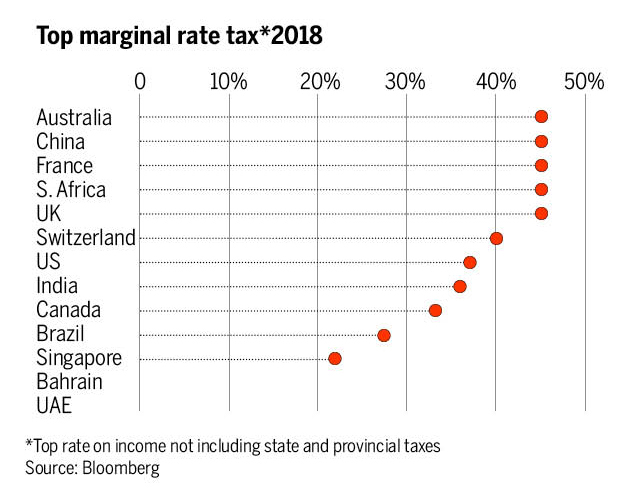
From: Bloomberg, This is what it takes to be in the 1% in India, February 10, 2020: The Times of India
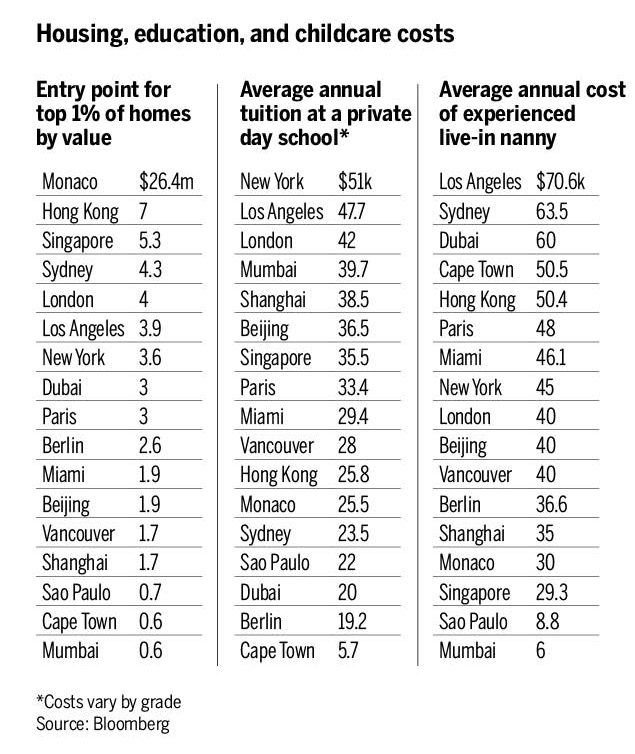
From: Bloomberg, This is what it takes to be in the 1% in India, February 10, 2020: The Times of India
NEW DELHI: The "top 1%" is the symbol of wealth and power thanks to a protest movement. Since Occupy Wall Street popularised the term almost a decade ago, inequality has surged, and this exclusive group has only gotten richer and more influential.
Yet the top 1% covers a wide span, from prosperous professionals to billionaires with more wealth than many nations. And the difficulty of making the cut varies greatly depending on where you live.
To join the group in the oil-rich United Arab Emirates (UAE) requires more than $900,000, or 12 times more income than in India, a developing market so populous that the top 1% includes more than 13 million souls. In much of the developed world, an income of $200,000 to $300,000 gets you in the top 1%.
In the US, the wealthy have been pulling away from the middle and working classes, whose incomes have barely grown for the past couple of decades. Inequality is widening even within the ranks of the top 1%. While it takes about $500,000 per year to enter the top 1% of Americans, reaching the 0.1% now requires an annual income of more than $2 million. The threshold for the 0.01% is more than $10 million.
What they owe
Some countries make special efforts to attract the global 1% and their wealth. Singapore and Monaco, for example, have turned themselves into tax shelters where the well-off can live and invest under a lighter tax and regulatory burden. Some nations rich in oil and gas can also afford not to tax the top 1%.
In most of the world, though, politicians use taxes to try to level the playing field between the wealthy and everyone else. In many nations with a progressive income tax, the highest rates apply only to the richest portion of the 1%.
What they spend
The rising wealth of the world’s top 1% has prompted a boom in luxury spending, especially in China. McKinsey & Co estimates spending on personal luxury goods like accessories, jewelry and watches is up 47% since 2012.
Many members of the top 1% have little interest in designer handbags or high-end fashion, of course. Housing, education and child care are far more common expenses for this group, and their costs can vary widely around the world.
A common theme from city to city is a fierce competition for English-speaking international schools, according to Gail Rabasca, executive vice president at relocation consulting firm Chamness WorldWide, as expatriates fight for spots with local children whose parents “want more competitive educational positioning and intercultural awareness for their children.”
The prices for high-end real estate in major global cities jumped from 2010 to 2018, but growth has slowed more recently, said Liam Bailey, global head of research at Knight Frank. The problem is a backlog of supply and a sense that costs are too inflated, he said. “There are limits to how high very wealthy individuals will bid prices.”
Countries with the most millionaires
2000>2020

From: July 12, 2021: The Times of India
See graphic:
Millionaires in India and the world, 2000>2020
2018> 19

From: Nov 13, 2019: The Times of India
See graphic:
India, Australia, Brazil, China, France, Germany, Japan, the UK and the USA: The countries with the most millionaires in 2018 and 19.
2024: Mumbai tops Asia in no. of billionaires, in 3rd spot globally
March 26, 2024: The Times of India
With 92 billionaires, Mumbai has overtaken Beijing (91) as Asia’s billionaire capital for the first time. It now ranks third globally in terms of billionaires behind New York (119) and London (97), shows a study.
Mumbai’s total billionaire wealth stands at $445 billion, a 47% jump from 2023. China has 814 billionaires against India’s 271, Hurun Research’s 2024 Global Rich List shows. In the global rich list, Reliance Industries’ Mukesh Ambani has maintained his stronghold at the 10th position. The others on the list include Gautam Adani, Shiv Nadar and his family, Cyrus S Poonawalla, Dilip Shanghvi, Kumar Birla and Mangal Prabhat Lodha.
Details
March 26, 2024: The Times of India

From: March 26, 2024: The Times of India
Mumbai:There are now more billionaires in Mumbai’s 603 sq km than there are in Beijing’s over 16,000 sq km. By overtaking the Chinese megalopolis, Mumbai has become Asia’s billionaire capital for the first time.
While China has 814 billionaires compared to India’s 271, Mumbai hosts 92 billionaires against 91 in Beijing, Hurun Research’s 2024 Global Rich List showed. Mumbai now ranks third globally in terms of billionaires after New York, which regained its top status after seven years with 119 billionaires, followed by London with 97.
The Maximum City has managed to overtake China’s political and cultural capital because of the 26 new billionaires it has added in a year. Beijing, in the same time, has seen a 18 erstwhile billionaires drop out of the list on a net basis.
Mumbai’s total billionaire wealth stands at $445 billion, with a 47% increase from the previous year, while Beijing’s total billionaire wealth amounts to $265 billion, a 28% decrease.
Mumbai’s wealth sectors include energy and pharmaceuticals, with billionaires like Mukesh Ambani experiencing significant gains. Real estate player Mangal Prabhat Lodha (and family) was Mumbai’s biggest wealth gainer in percentage terms (116%).
In the global rich list, Indian billionaires have seen a slight drop in world ranking; Mukesh Ambani maintains his stronghold at 10th position with a substantial increase in wealth, primarily attributed to Reliance Industries. Similarly, Gautam Adani’s remarkable surge in wealth propelled him up eight positions globally to the 15th rank.
HCL’s Shiv Nadar and his family witnessed a notable ascent in both wealth and global ranking (up 16 places to 34). Conversely, Serum Institute’s Cyrus S Poonawalla experienced a modest decrease (down 9 places to 55) with total wealth of $82 billion.
Further contributing to India’s billionaire cohort’s dynamics are Sun Pharmaceuticals Dilip Shanghvi (61st position) and Kumar Mangalam Birla (100). Radhakishan Damani’s modest yet steady wealth growth, fuelled by DMart’s success, has seen him move up eight places to 100.
Inheritor clans/ 2nd generation and after
India’s place in Asia/ 2023-24; 2019-14
Bloomberg, February 12, 2024: The Times of India

From: Bloomberg, February 12, 2024: The Times of India
Indian Family Billionaires Lead Asia’s Surge, Hong Kong’s Suffer Reversal
Keep in mind, the list doesn’t include first-gen wealth creators like Jack Ma and Gautam Adani. It also excludes fortunes of single heirs
Over A Quarter Of Asia’s 20 Richest Clans Are Indian
Six of Asia’s 20 richest clans are from India. The divergence is an indication of how the concentration of wealth and power in Asia is shifting as China’s growth slows
Ambani’s Wealth, Reliance Market Cap At Record Highs
Ambani family’s fortune ($103 billion) and RIL stock have both hit record highs in recent weeks The six Indian clans are together worth $219 billion, which is 41% of the total wealth of Asia’s top 20 The stock market boom has also bolstered Mistry, Jindal, Birla and Bajaj fortunes
Number of $-millionaires
2000-18: wealth per Indian; growth of debt
India has 3.4L $-millionaires with $6tn total wealth: Study, October 19, 2018: The Times of India
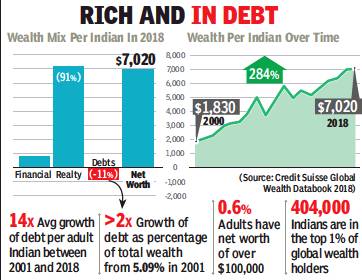
From: India has 3.4L $-millionaires with $6tn total wealth: Study, October 19, 2018: The Times of India
Amid rising concern over increasing inequality, the country created a whopping 7,300 more millionaires during the 12 months to mid-2018, taking the total number of dollar-millionaires to 3.43 lakh, who are collectively worth around $6 trillion, says a report.
According to Credit Suisse, the country is home to one of the highest proportions of female billionaires at 18.6% during the period, among the major countries. Of the total dollar-millionaires, 3,400 have wealth over $50 million, while 1,500 have over $100 million each, said the Credit Suisse’s 2018 global wealth report. And the number of the rich as well the inequality is set to widen by over 53% by 2023 when their number is set to cross an estimated 5,26,000 millionaires worth around $8.8 trillion.
The report said Indians’ personal wealth is dominated by property and other real assets, which make up 91% of estimated household assets. Over the past 12 months, non-financial assets grew by 4.3%, accounting for all of the wealth growth in the country, it noted. House-price movements are a proxy for the non-financial component of household assets, which reached a high of 9% for the country.
Globally, the US continues to lead the rich club for the 10th year in a row. During the reporting period too, the US contributed the most to global wealth, adding an $6.3 trillion, taking the total to $98 trillion. Since 2008, the US has been continuing its unbroken run of growth in total wealth and wealth per adult annually. China is home to the second-largest number of wealthy households, having added $2.3 trillion to reach $52 trillion.
2012-17/ Bangladesh, India, Pakistan, growth of ultra HNIs
November 12, 2018: The Times of India
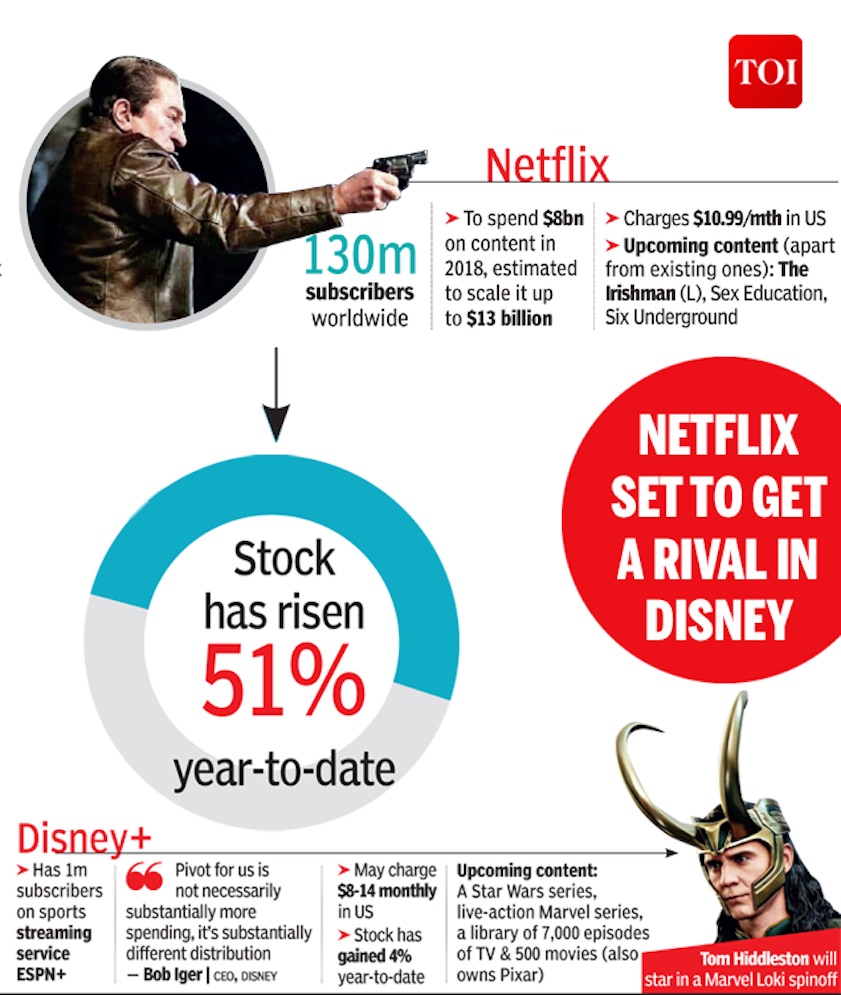
From: November 12, 2018: The Times of India
See graphic:
2012-17/ Bangladesh, China, India, Pakistan, growth of ultra HNIs
On November 8, 2018, Disney said streaming service will kick off in 2019, pitting it against market leader Netflix and others like Amazon Prime Video and AT&T’s upcoming offer. The service is called Disney+ and will source content from a vast in-house library and also produce original series. Disney content from Netflix will be moved back to the Mouse House, putting pressure on the streaming co. Netflix has been expanding its operations in Asia.
2018: Only 61 have income of over Rs 100 cr
There were only 61 individuals who declared an income of more than Rs 100 crore during assessment year 2017-18, though the number has risen sharply from 38 in the previous year.
This information was provided by minister of state for finance Pon Radhakrishnan to the Lok Sabha in a written reply on Friday.
The number of individuals disclosing a gross total income of more than Rs 100 crore in a year in his/her return of income filed with the Income Tax (I-T) department was 24 in assessment year 2014-15 and since then it has been steadily rising.
The minister also said there was no official/uniform definition of classification of a person as 'billionaire'.
Replying to another question, minister of state for finance Shiv Pratap Shukla said that government is taking action under Benami Properties Transactions Act, and properties valued at Rs 6,900 crore were under attachment by agencies.
"The income tax authorities till December 2018 have identified more than 2,000 benami transactions," he added.
These include, deposits in bank accounts, plots of land, flat and jewellery, he said, adding that provisional attachment of properties have been done in over 1,800 cases.
2020: 6,000 UHNWI Indians worth ₹215cr + each
March 6, 2020: The Times of India
6,000 Indians have ultra-high net worth of over ₹215cr each
India has 5,986 ultra-high net worth individuals (UHNWI), each with over US$ 30 million (around Rs 215 crore), and it is globally ranked 12th on the list of countries with most such people.
The US dominates the list with over 2.4 lakh UHNWIs, followed by China with 61,587 and Germany 23,078, according to Knight Frank Wealth Report 2020 released Thursday. Globally, over 31,000 new UHNWIs were created in 2019, bringing the total to more than 513,200.
“The number of UHNWIs in India is predicted to grow by 73% in the next five years, almost doubling the count to 10,354 from 5,986 in 2019,” said the report. By 2024, Asia will be the world’s second largest wealth hub outperforming Europe, with a five-year growth forecast of 44%. However, it will reach only half the size of North America’s UHNWI population, which is predicted to rise 22% over the same period.
Inspite of wealth growth and record low interest rates in most advanced economies, the global economic slowdown weighed on prime property prices across the globe. For instance, Mumbai saw a growth of just 0.5% last year, Delhi 4.7% and Bengaluru 2.1%. Frankfurt and Lisbon topped the list with an annual price change of 10.3% and 9.6%, respectively. When it comes to luxury properties, Monaco remains the most expensive city where US$1 million (Rs 7.2 crore) can buy you a mere 16.4 square metre or 176 square feet of space.
Equity most attractive asset class for UHNWIs
Comparatively in Mumbai, you can buy 102.2 sq m or 1,098 sq ft (approximate size of a decent two-bedroom flat in the city). Shishir Baijal, chairman & MD, Knight Frank India, said, “While prime property prices have stayed stable in the past five years, the relative stability of the Indian rupee still allows investors and endusers to buy more prime real estate in India today than in 2015. At -1% for 2020, prime property price growth in Mumbai is expected to face challenges, as the current economic slowdown will continue to influence market liquidity.” Equity investments remained the most attractive asset class for Indian UHNWIs with 83% of them in India plan to increase or maintain their allocations in equities, followed by bonds (77%) and property (51%). So, which are the best cities for UHNWIs to live, invest and do business in? According to the Knight Frank City Wealth Index, New York captured the top spot from London based on wealth, investment and lifestyle. With London in the second spot, Paris, Hong Kong and Los Angeles round out the top five cities. The Luxury Investment Index shows that ‘collectable handbags’ has topped the index, rising in value by 13% over the 12 months to Q4 2019, knocking rare whisky off its number one position. “The index results show that on an annual basis, handbags outperformed both whisky and art, which both recorded growth of 5%,” it said.
US dominates the ranking with over 2.4 lakh UHNWIs, followed by China with 61,587 and Germany 23,078, according to the Knight Frank Wealth Report 2020. The number of UHNWIs in India is predicted to grow by 73% in the next five years, almost doubling the count to 10,354 from 5,986 in 2019.
2021: 1,000+ Indians worth Rs 1,000 crore
Sep 30, 2021: The Times of India
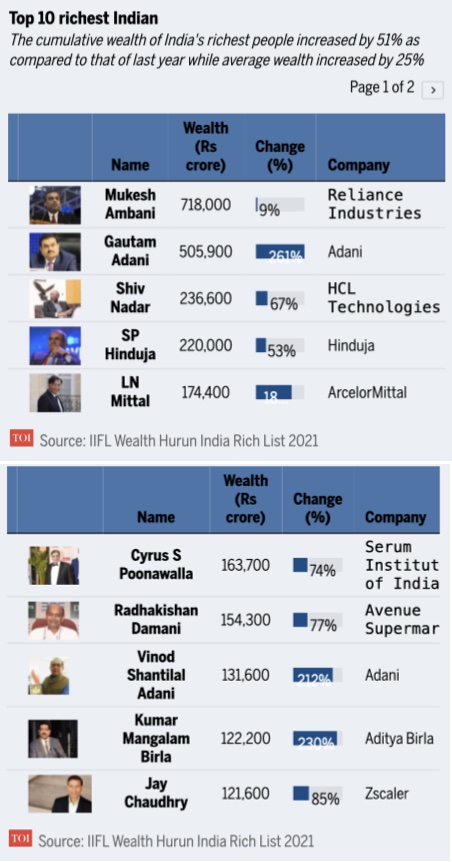
From: Sep 30, 2021: The Times of India
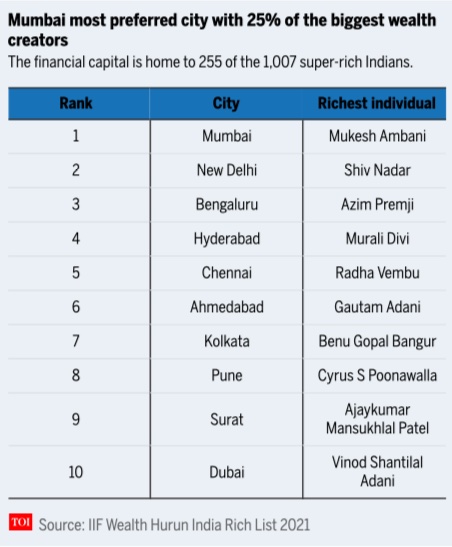
From: Sep 30, 2021: The Times of India
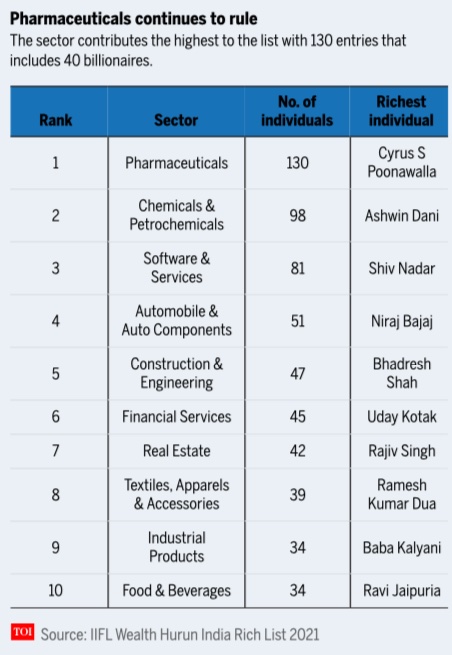
From: Sep 30, 2021: The Times of India
NEW DELHI: For the first time ever, over 1,007 individuals in the country have a net worth of Rs 1,000 crore, the IIFL Wealth Hurun India Rich List 2021 showed.
The report said that India experienced a glorious decade with the richest individuals cumulatively adding Rs 2,020 crore per day -- the fastest wealth creation ever experienced by the country. Out of these 1,007 individuals, 13 of them have more than Rs 1 lakh crore of wealth.
Even amid the pandemic situation which battered the economy, total wealth increased by 51 per cent while average wealth was 25 per cent higher.
Further, 894 individuals saw their wealth increase or stay the same, of which 229 new faces. Number of billionaires also jumped to 237 till September 15 this year.
"The number of entrants in IIFL Wealth Hurun India Rich List has grown 10 times in 10 years -- from just under 100 ten years ago to 1,007 today. At this rate, in 5 years, I expect the list to grow to 3,000 individuals," Anas Rahman Junaid, managing director and chief researcher at Hurun India said. He also noted that the wealth of rich listers fell by 30 per cent within 2 months of the Covid pandemic as economic activities came to a standstill owing to the lockdown.
However, pent up demand accompanied with timely government policies, accentuated investors interest and the Nifty and sensex jumped to all-time highs.
"The bull-market valuation multiples, resulted in 9 out of 10 people in the list witnessing either an increase or retention in their wealth compared to last year, while 116 individuals doubled their wealth,” he added.
Besides, wealth creation has become more decentralised as the number of cities jumped from 10 a decade ago to 76. At this rate, it is expected that the each of the planned 100 smart cities will have a rich lister within 5 years.
India has third largest no. of billionaires
The report further noted that India is third in the world, when it comes to no. of billionaires.
India is adding new billionaires at one of the fastest rates. At present, there are 237 billionaires in the country, 4 times more than what it was 10 years ago. India is also the second fastest growth in the world after China.
Mukesh Ambani retained No. 1 spot for 10th year
Reliance Industries chairman Mukesh Ambani emerged to be richest Indian for the 10th consecutive year.
With 9 per cent jump, his total wealth stood at Rs 7,18,000 crore. RIL became the first Indian company to cross the Rs 16 lakh crore market valuation.
According to Hurun Global 500 most valuable companies 2021, within four decades of operation, RIL has become the 57th most valuable company in the world.
Others in top 5
Adani Group chief Gautam Adani moved up two places to the second place in the latest rankings. He is now the second richest Asian after Ambani, overtaking China's bottled water producer Zhong Shanshan.
HCL Technologies founder Shiv Nadar retained the third spot with 67 per cent rise in his wealth. The company became third IT firm to break through the $10 billion revenue mark. Hinduja Group's SP Hinduja & family held the fourth place with Rs 2,20,000 crore up 53 per cent, while ArcelorMittal chief LN Mittal with Rs 1,74,400 crore held the fifth place.
Four new faces in top 10
The top ten list this year has four new faces, led by steel tycoon Lakshmi Mittal of ArcelorMittal, Kumar Mangalam Birla of the Aditya Birla Group, along with California based Jay Chaudhry of cloud computing and cyber security firm Zscaler.
Richest woman
Among the women, the third generation Godrej family member Smita V Crishna is the richest woman in the list with Rs 31,300 crore (down 3 per cent), followed by Kiran Mazumdar-Shaw (who is also the richest self-made woman in the list) with Rs 28,200 crore, down 11 per cent.
Mumbai preferred city for biggest wealth creators
Mumbai justified its name as the financial capital being home to 255 of the 1,007 super-rich creating 38 more in the year.
The national capital held the second spot by adding 39 to take the number to 167 and Bengaluru with 85, added 18 more in the year. Gujarat added 15 rich listers to overtake Tamil Nadu to the fourth place in the list.
Pharma minted most no. of billionaires
With 130 individuals on the list, the report said that pharmaceutical sector minted the most number of billionaires.
While, chemicals and petrochemicals comprised 98 and 81 were from software and services.
Out of the 130 individuals in pharma sector, 40 of them were billionaires.
The sector witnessed 43 per cent growth in wealth during 2021, up from 36 per cent in 2020.
2021: UHNWIs in India and the world

From: Nov 11, 2022: The Times of India
See graphic:
2021: UHNWIs in India and the world
Projections for 2026
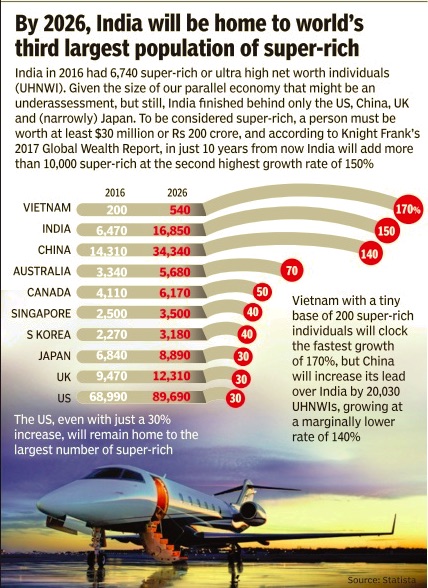
See graphic:
Projections for richlist, 2026, India and the world
Real estate tycoons
As in 2018
BJP MLA from Malabar Hill, Mangal Prabhat Lodha (62) has been ranked the richest builder in India with a wealth of Rs 27,150 crore, according to the GROHE Hurun India Real Estate Rich List 2018 released on Wednesday. In 2017, he was second with a wealth of Rs 18,610 crore. Jitendra Virwani (52) of Embassy Property Developments, secured the second spot with a wealth of Rs 23,160 crore. In 2017, he was at No. 3 with a wealth of Rs 16,700 crore.
NCR-based DLF's promoter Rajiv Singh featured at No. 3 place with a wealth of Rs 17,690 crore. In 2017, DLF's promoter and Rajiv Singh's father K P Singh was at the top position with a wealth of Rs 23,460 crore. But due to the slowdown in the real estate, in NCR particularly, the fortunes of realtors in the region has taken a hit.
With a fortune of Rs 2,780 crore, Renuka Talwar (62), daughter of DLF chairman K P Singh, is the richest woman in the real estate rich list.
According to the report, Mumbai is the most preferred city of residence for real estate tycoons in India with 35 names hailing from the city, followed by Delhi (22) and Bengaluru (21). Total wealth of the top 100 real estate barons featured in the list accounted for Rs 2,36,610 crore ($32.7 billion) in 2018 - up 27% from 2017 edition's cumulative wealth of Rs 1,86,700 crore ($28.6 billion).
The list was compiled on the basis of net worth of living Indians as on September 30, 2018, when the rate of exchange to the US dollar stood at Rs 72.46. The list relates to Indians only, defined as born or brought up in India.
The report further revealed that 59% of the names featured are first-generation entrepreneurs. Average age of the participants is 59 years, with the youngest being 24 years (Kunal Menda of RMZ) and the eldest at 89 years (Prithvi Raj Singh Oberoi of East India Hotels). "Only four names aged below 40 years were featured in the list - indicating that the experienced and long-standing names build wealth in the long run from this sector in India, said the report.
Nine women featured on the list - with Talwar of DLF being the richest woman ranked at 19. Among the 10 debutants in the list, Rameshwar Rao Jupally of My Home Constructions ranked the highest at 14 among the top 100.
Hurun Report India MD & chief researcher Anas Rahman Junaid said, "The combined wealth of top 100 names listed by us in 2018 stands at $32.3 billion, or in other words, a billion dollars more than the GDP of Cyprus."
Cities with the most real-estate tycoons
As in 2018
Delhi 2nd most preferred city of residence for realty tycoons, November 22, 2018: The Times of India
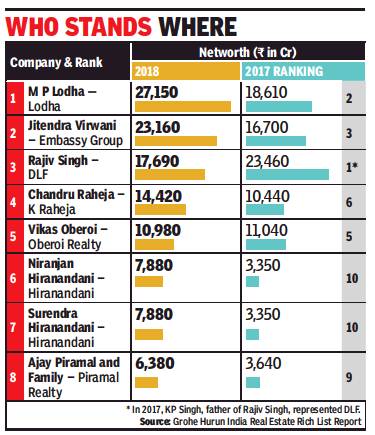
From: Delhi 2nd most preferred city of residence for realty tycoons, November 22, 2018: The Times of India
BJP MLA from Malabar Hill, Mangal Prabhat Lodha (62) has been ranked the richest builder in India with a wealth of Rs 27,150 crore, according to the GROHE Hurun India Real Estate Rich List 2018 released on Wednesday. In 2017, he was second with a wealth of Rs 18,610 crore. Jitendra Virwani (52) of Embassy Property Developments, secured the second spot with a wealth of Rs 23,160 crore. In 2017, he was at No. 3 with a wealth of Rs 16,700 crore.
NCR-based DLF’s promoter Rajiv Singh featured at No. 3 place with a wealth of Rs 17,690 crore. In 2017, DLF’s promoter and Rajiv Singh’s father K P Singh was at the top position with a wealth of Rs 23,460 crore. But due to the slowdown in the real estate, in NCR particularly, the fortunes of realtors in the region has taken a hit.
With a fortune of Rs 2,780 crore, Renuka Talwar (62), daughter of DLF chairman K P Singh, is the richest woman in the real estate rich list.
According to the report, Mumbai is the most preferred city of residence for real estate tycoons in India with 35 names hailing from the city, followed by Delhi (22) and Bengaluru (21). Total wealth of the top 100 real estate barons featured in the list accounted for Rs 2,36,610 crore ($32.7 billion) in 2018 — up 27% from 2017 edition’s cumulative wealth of Rs 1,86,700 crore ($28.6 billion).
The list was compiled on the basis of net worth of living Indians as on September 30, 2018, when the rate of exchange to the US dollar stood at Rs 72.46. The list relates to Indians only, defined as born or brought up in India.
The report further revealed that 59% of the names featured are first-generation entrepreneurs. Average age of the participants is 59 years, with the youngest being 24 years (Kunal Menda of RMZ) and the eldest at 89 years (Prithvi Raj Singh Oberoi of East India Hotels). “Only four names aged below 40 years were featured in the list — indicating that the experienced and long-standing names build wealth in the long run from this sector in India,’’ said the report.
Nine women featured on the list — with Talwar of DLF being the richest woman ranked at 19. Among the 10 debutants in the list, Rameshwar Rao Jupally of My Home Constructions ranked the highest at 14 among the top 100.
Hurun Report India MD & chief researcher Anas Rahman Junaid said, “The combined wealth of top 100 names listed by us in 2018 stands at $32.3 billion, or in other words, a billion dollars more than the GDP of Cyprus.”
UHNIs/ UHNWIs, city-wise
2020-23: Top 8 cities vis-à-vis other cities

From: April 11, 2024: The Times of India
See graphic:
Ultra-high net worth individuals (UHNWI)/ UHNIs in India’s Top 8 cities vis-à-vis other cities, 2020-23
Women
2025
Cherry Gupta, February 18, 2025: The Indian Express
Top 10 Richest Women in India 2025: India, one of the fastest-growing economies, which is set to be the third largest by 2030, has undergone a transformation. Last year, in 2024, India experienced a boom in wealth creation—ranking third globally in terms of countries with the most number of billionaires.
India has held the position of having the fifth-highest number of female billionaires worldwide, according to a study by City Index.
Indian women are stepping into the limelight, breaking through traditional barriers, and accumulating considerable wealth as they ascend the ranks of the nation’s billionaires.
This year, at the forefront, is Savitri Jindal, who maintained her position from the previous year and, is the wealthiest Indian woman in 2025, boasting a net worth of $38.5 billion.
Furthermore, in a notable mention, the co-founder of Zoho Corp, Radha Vembu‘s impressive leadership, propelled her forward in the ranks, elevating her from 9th to 7th place among India’s wealthiest women in the Forbes Billionaire list for 2025.
Rounding up the list is Falguni Nayar, founder of Nykaa, a popular beauty e-commerce platform which was launched in 2012. A former investment banker, Nayar’s fortune increase by an incredible 963% in 2021.
Top 10 Richest Women in India, as of January 2025
While the women billionaires in India featured in the list are the same as last year, there have been significant shifts in rankings and net worth, as highlighted by the Forbes Billionaires List 2025, reflecting the ever-evolving nature of wealth accumulation.
With the entrepreneurial spirit propelling many women in business today, below are the top 10 Indian women who are not only shaping the future but also establishing their presence as billionaires in India, as of January 2025.
| Rank 2025 | Name | Net Worth (USD) | Company | Global Rank 2025 |
|---|---|---|---|---|
| 1 | Savitri Jindal | $34.3 billion | Jindal Group | 52 |
| 2 | Rekha Jhunjhunwala | $8.0 billion | Titan Company Limited, and others | 356 |
| 3 | Renuka Jagtiani | $5.6 billion | Landmark Group | 592 |
| 4 | Vinod Gupta | $4.7 billion | Havells | 709 |
| 5 | Smita Crishna-Godrej | $3.5 billion | Godrej | 970 |
| 6 | Kiran Mazumdar-Shaw | $3.4 billion | Biocon | 1034 |
| 7 | Radha Vembu | $3.2 billion | Zoho Corporation | 1074 |
| 8 | Anu Aga | $3.1 billion | Thermax | 1107 |
| 9 | Leena Tewari | $3.0 billion | USV Pharma | 1133 |
| 10 | Falguni Nayar | $2.9 billion | Nykaa | 1148 |
Source: Forbes
Note: Since stock prices fluctuate routinely, the net worth might change accordingly. The net worth mentioned is as of January 27, 2025.
B
SOME BROAD YEAR-WISE TRENDS
For details see our annual Rich-list pages, such as
Rich List: India <> Rich List: India, 2014: Forbes <>Rich List: India, 2014: Hurun <>Rich List: India, 2015: Forbes <> Rich List: India, 2015: Hurun <>Rich list, India: 2016 <> Rich List: India, 2016: Forbes <> Rich List: India, 2017 <> Rich List: India, 2017: Hurun<> Rich list, India: 2018<> Rich list, India: 2019<> Rich List, India: 2020<> Rich List, India: 2021
2007-08
Top taxpayers
City Resident Ranks No. 1 With Rs 121cr; Ambani Bros Not In Top 200
Maya, SRK among top taxpayers
Pradeep Thakur | From the Archives of ‘‘The Times of India’’: 2008 August 3, 2008 2008
New Delhi: Mayawati is the top taxpayer among politicians and, in fact, ranks among the 20 top taxpayers in the country. In 2007-08, the Dalit leader shelled out Rs 26.26 crore as income tax, according to the I-T department’s compilation of the top 200 taxpayers’ list.
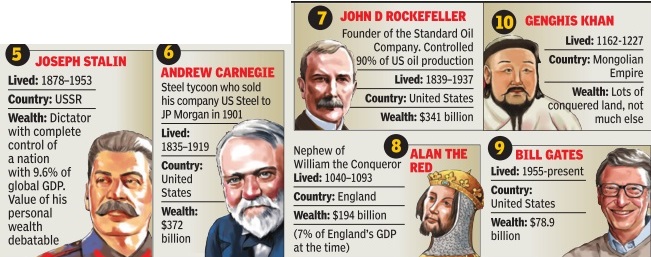

And King Khan is the top taxpayer among actors. Placed at No. 13, five slots higher than Mayawati, Shah Rukh paid Rs 34.2 crore as income tax in 2007-08. The next actor who is cited among taxpaying notables is Akshay Kumar, who ranks at No. 40 in the list, and paid Rs 13.5 crore as tax.
Sachin Tendulkar is the only cricketer to figure in the top-200 list. He coughed up Rs 8.8 crore as tax, reinforcing the belief that he earns way more than other cricketers as the country’s top sporting brand. Placed 81 in the top-200, Sachin is just ahead of industrialist Kumarmangalam Birla who paid just Rs 48,271 less than the master blaster.
Talking of industrialists, conspicuous by their absence in the top-200 list are the Ambani brothers, Mukesh and Anil. Their mother, Kokilaben, barely makes it to the list at 195, having paid Rs 4.46 crore as tax. The top taxpayer among industrialists is Max’s Analjit Singh who is No. 15 in the list having paid Rs 31.49 crore as tax.
Otherwise, the top taxpayers of the country are not public figures, but obviously guys rolling in the stuff. The country’s top taxpayer is from Delhi who forked out Rs 121 crore as income tax. In the top-10, five are from Mumbai and two from Delhi. Income-tax officials requested TOI not to make public identities of top taxpayers as they are not protected by their celebrity status, and often attract the attention of extortionists.
Coming back to Mayawati, her income, year after year, ostensibly comes from ‘‘gifts’’ from her admirers. Having paid a tax of Rs 26 crore, her personal income this year is estimated in the region of Rs 75-80 crore.
Salman, Ash among top-200 taxpayers
New Delhi: It may be recalled that Kum. Mayawati faces a CBI case for holding assets disproportionate to her known income.
The other interesting names featuring in this year’s list of top-200 taxpayers are, cardio-surgeon Naresh Trehan (Rs 8.4 crore), actor Salman Khan (Rs 7 crore), stamp-paper scamster Abdul Telgi (Rs 6.5 crore), Sanjay Dutt (Rs 5.8 crore), Aishwarya Rai (Rs 5.6 crore), Abhishek Bachchan (who paid just Rs 75,192 less than his wife), industrialist Nandan Nilekani (Rs 5.16 crore), music director-singer Himesh Reshammiya (Rs 4.89 crore), top lawyer Mukul Rohtagi (rs 4.85 crore), actor Aamir Khan (Rs 4.72 crore) and Wipro boss Azim Premji (Rs 4.68 crore).
2000-2015
India's wealth rises 211%
The Times of India, Oct 29 2015
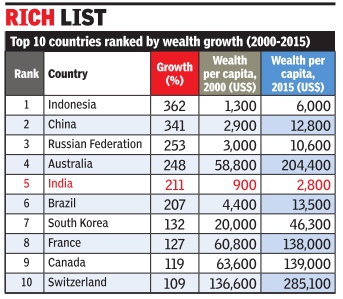
Kounteya Sinha
India has seen a whopping 211% increase in its wealth over the last 15 years -much higher than the US, UK, Japan, France, Germany or Brazil. Only four other countries -Indonesia, China, Russia and Australia -have done better than India. Indonesia's wealth increased by 362% while China saw an increase of 341%, Russia 253% and Australia 248%.
Some of the major western countries have seen a marginal increase in their wealth over the last decade and a half. While Japan saw its wealth increase by a modest 39%, it was 41% for the US and 58% for the UK.
In India, wealth per capita increased from $900 in 2000 to $2,800 in 2015. India is now the 10th richest country in the world, ranked according to total individual wealth.“Total individual wealth“ refers to the private wealth held by all the individuals in each country .
The downside, however, is India and Indonesia make it to the top 20 richest list due to their large populations.On a per capita basis, the two countries are quite poor.
When ranked according to per capita wealth, India ranks last in the top 20 countries. According to the New World Wealth's report on the wealthiest 20 countries in the world, when looking at per capita wealth, Switzerland topped the charts with $285,100 per capita wealth followed by Australia ($204400), US ($150600) and UK ($147600). New World Wealth had earlier revealed that Pune was India's fastest growing city with multi-millionaires and seven of the 20 fastest growing cities for the super-rich in Asia Pacific were from India.
Pune saw a whopping 317% growth in the number of multi-millionaires between 2004 and 2014 -the numbers increasing from 60 to 250.Overall, Pune is ranked third fastest growing city for the super-rich in the Asia Pacific region after Ho Chi Minh City in Vietnam, which saw a 400% growth (from 40 to 200), and Jakarta, which recorded a 396% increase (from 280 to 1390) multimillionaires.
Mumbai was ranked fourth fastest city with a 220% increase -840 multimillionaires in 2004 increasing to 2690 in the next 10 years. Hyderabad took the fifth rank with 510 multi-millionaires at present (a 219% increase in the last decade).
Delhi which is home to 1,350 multi-millionaires in 2014 as against 430 in 2004 -recorded an increase by 214%.
2000-19
New billionaires join and/ or replace the old
May 8, 2019: The Times of India
The rise of India's new billionaires and the fall of the old
NEW DELHI: India is going through one of the greatest periods of wealth creation — and destruction — all at the same time.
A new breed of self-made entrepreneurs is vaulting into the ranks of the wealthy, offsetting billions lost by debt-burdened industrialists and members of the country’s old dynasties. The changes are set to help India’s ultra-rich population grow at the world’s fastest pace. It’s a shift shaped partly by a debt-fueled expansion that left businesses from power generation to airlines with $190 billion in soured loans. Over the past few years, Prime Minister Narendra Modi’s government has cracked down on delinquent borrowers, and India’s banks moved to seize their assets, a dramatic change for a country where the wealthy once enjoyed almost complete protection.
While old business clans continue to dominate India’s rich lists, a tenfold expansion in its economy since its opening in the 1990s has spawned new tycoons in fields like technology. The number of billionaires in India more than doubled to 119 between 2013 and 2018, according to Knight Frank. And the country will lead the global growth in ultrahigh net worth individuals, with its numbers rising 39 per cent to 2,697 by 2023, the researcher estimates.
"The business environment has improved over the years," said Charles Dhanaraj, a professor at the Fox School of Business at Temple University in Philadelphia. "The availability of venture capital and private equity has changed the opportunity space for promising businesses. So we should see more of these startups and scaleups in the coming years."
Here are some well-known names who have seen a shift in their fortunes:
Old money
Telecom troubles:
Anil Ambani, the younger brother of Asia’s richest man, inherited some of the newer businesses of Reliance Industries Ltd in 2005 as part of a settlement with older sibling, Mukesh, following the death of their father Dhirubhai Ambani three years earlier. Now, more than a decade later, the younger Ambani has been fending off creditors and fighting multiple cases in courts amid his phone carrier Reliance Communications Ltd’s slide into bankruptcy. A representative for Anil Ambani didn’t comment. The value of his holdings in companies has plunged to about $120 million from a net worth of at least $31 billion in 2008, according to the Bloomberg Billionaires Index.
A boom and crash:
The first-generation entrepreneurs, Shashi and Ravi Ruia, started the Essar Group in 1969 as a construction company. Later they diversified into new businesses, investing about $18 billion between 2008 and 2012. The excessive leverage across the group and some adverse policy actions forced them to sell many of their assets. The Ruia brothers were jointly worth more than $4 billion at the start of 2015, and have since lost their billionaire status, according to the Bloomberg Billionaires Index.
The turbine maker:
Tulsi Tanti’s Suzlon Energy Ltd purchased German REpower Systems for nearly $2 billion in 2007 to be hailed as a global company, but things went downhill from there. Once the world’s top turbine maker, Suzlon’s debt-driven expansion caused one of India’s largest corporate debt default in 2012. Seven years later Tanti is struggling to repair his company’s finances. Tanti, who had a net worth of more than $5.7 billion in 2007, has lost his billionaire status, according to data compiled by Bloomberg.
The beer baron:
After inheriting his father’s liquor empire, Vijay Mallya, started Kingfisher Airlines Ltd. Struggling to repay lenders, the carrier was grounded seven years later. Mallya is currently fighting an extradition case in London after fleeing India. Lenders have sought to recover as much as $1.5 billion from the man known as "the king of good times" for his flamboyant lifestyle.
New money
Retail tycoons:
Binny Bansal and Sachin Bansal, who aren’t related, created Flipkart, India’s largest online retailer, within a decade. Last year, they sold their company to Walmart Inc, becoming billionaires. Binny left shortly after, with Walmart said to have conducted an inquiry into a consensual relationship he had with a woman. He still holds 4 per cent of Flipkart and a board seat. Sachin exited Flipkart at the time of the Walmart acquisition.
The payment guru:
Vijay Shekhar Sharma founded One97 Communications in 2000 when fewer than 10 million Indians were online. Business at his Paytm digital payment unit soared after the government eliminated 500 and 1,000 rupee banknotes at the end of 2016. An August 2018 funding round valued One97 at more than $10 billion, people familiar with the matter said at the time. Sharma currently owns 15 per cent of the company, according to a person familiar with the matter.
Laws of motion:
Byju Raveendran, chief executive of Bangalore-based Think & Learn Pvt, launched the Byju’s K-12 education app in 2015. His videos explain fractions or the laws of motion at a conceptual level, drawing almost 30 million users from 1,700 cities. A December funding round valued it at $3.6 billion. Raveendran, his wife and brother together own about 36 per cent, according to Raveendran.
2013
Indian millionaire households: no.15
India ranks 15th on global wealth list
New York PTI Jun 11 2014
According to Boston Consulting Group's report, India had 175,000 millionaire households in 2013 and is projected to become the seventh wealthiest nation by 2018
India had 175,000 millionaire households in 2013, ranking 15th in the world, according to a wealth report which said the total number of millionaire households in the world rose to 16.3 million last year.
The Boston Consulting Group’s 14th annual report on the global wealth-management industry ‘Riding a Wave of Growth: Global Wealth 2014’ said global private financial wealth grew by 14.6% in 2013 to reach a total of $152 trillion.
The rise was stronger than in 2012, when global wealth grew by 8.7%. The key drivers, for the second consecutive year, were the performance of equity markets.
India ranked 15th last year and had 175,000 millionaire households. Its position improved slightly from 2012 when it had ranked 16 in the world for its number of millionaire households.
India is projected to become the seventh wealthiest nation by 2018. The number of ultra-high-net-worth households in India, those with $100 million or more, stood at 284 last year.
The total number of millionaire households reached 16.3 million in 2013, up strongly from 13.7 million in 2012 and representing 1.1% of all households globally.
2013-15: ESOP enriches ITC, BFSI, FMCG employees
The Times of India Jan 09 2016
Namrata Singh & Shubham Mukherjee
TNN
Banking, FMCG Execs Book Max Gains On ESOP Accounts
If you thought technology and multinational companies are the best wealth creators for employees at India Inc, think again. Though conventional wisdom drives you to that conclusion, in reality a new breed of wealth creators has emerged ever since the employee stock option plan (ESOP) was pioneered by Infosys in the mid-nineties.
Till about four years back, ESOPs were predominantly concentrated among MNCs and the IT sector. But a TOI study has revealed that over the last three financial years, employees of BFSI (banking and financial services) companies have recorded the maximum returns on their stock options followed by FMCG (fast moving consumer goods) companies. And it's an Indian company , ITC, which leads the list of top 100 listed companies on a cumulative basis.
The study , commissioned to staffing company Randstad India by TOI, on value creation and impact of ESOPs on performance of the BSE 100 companies over the last three financial years reveals that employees of the cigarette-tohotels major recorded the highest realizations cumulatively by exercising stock options (Rs 6,400 crore) followed by HDFC Bank (Rs 5,800 crore) and HDFC (Rs 4,300 crore). MNCs didn't figure high on the list of employee wealth cre ators, with Oracle Financial Services Software ranked No 18. IT sector's top ranker HCL Technologies stood at No 6.
“ITC's record of retaining quality talent has always been ahead of most Indian companies. While the introduction of the ESOP scheme has contributed to reinforcing ITC's talent retention capability , the real benefit has been in enhancing and sustaining the growth of ITC's businesses,“ said Anand Nayak, HR head, ITC.
In India, ESOPs are specifically offered to middle and senior management or employees who have completed a certain tenure in the organization.
L&T chairman A M Naik recently told TOI that his company has created more crore pati employees in India through ESOPs than any other, outside the technology space. L&T stands at No. 4 in the study .
Moorthy K Uppaluri, MD & CEO, Randstad India, feels ESOPs can play a powerful role if organizations leverage them in tandem with other tools for employee engagement and retention. “Typically , ESOPs tend to enhance employee ownership, thus fostering a performance-oriented environment. This can serve as a point of differentiation in the way the company operates and interacts with its stakeholders,“ he said.
2014
2014, Feb: The Hurun Global Rich List 2014 and India
See Rich List: India, 2014: Hurun
2014: Knight Frank's Wealth Report ranks India at no. 6 with 60 billionaires
India to have 4th highest number of billionaires by 2023: Report
Nauzer Bharucha,TNN | Mar 6, 2014
MUMBAI: Number of ultra high net worth individuals in India expected to double over next 10 yrs, rising by 126 per cent in Mumbai alone and around 118 per cent in Delhi. Mumbai is on the 4th spot with a 126 per cent growth among all global cities which is expected to increase from 577 to 1,302 by 2023.
Mumbai retains its position as 16th most expensive city in luxury home sector, according to Knight Frank's 8th edition of the Wealth Report released just now.
"By 2023, only 3 countries in the world, USA, China and Russia will have more billionaires than India," Samantak Das, chief economist and director research, Knight Frank India.
India is now on 6th spot [according to Knight Frank’s Wealth Report] in the top 10 countries for billionaires as of 2013 with 60 billionaires. This number is expected to increase to 119 with a 98 per cent growth by 2023, according to a Knight Frank Wealth Report.
The 2014 Wealth Report, an annual global perspective on prime property and wealth by property management firm Knight Frank, projected that the number of billionaires in India will grow by an exponential 98 per cent to 119 in the year 2023 from 60 billionaires last year.
India will rank fourth after US, China and Russia in 2023 and will have more billionaires than the UK, Germany and France, according to the report.
"Wealth creation in India, the world's third-biggest economy, is also expected to accelerate, with the number of Ultra High Networth Individuals (UHNWIs) forecast to nearly double over the next decade," the report said.
"This reflects the more positive outlook for India's economy after 2013 was marked by capital outflows and a sharp devaluation of the rupee. This tough environment for wealth creation and preservation was reflected in the one per cent decline in the number of UHNWIs in the country during the year," it said.
The report said the number of centa-millionaires (those with $100 million in disposable assets) in India is also projected to grow 99 per cent to 761 in 2023 from 383 last year.
The country will further see an increase of 99 per cent in the number of UHNWIs to 3130 in 2023 from 1576 last year.
The growth of UHNWIs in China and India, coupled with a whopping 144 per cent increase in Indonesia and 166 per cent hike in Vietnam, will help push the total number of UHNWIs in Asia up by 43 per cent to 58,588 by 2023, overtaking the total number in North America.
The number of billionaires in Asia is also forecast to overtake the number in Europe over the next decade.
Asian cities are also expected to see the fastest growth in the number of ultra wealthy individuals over the next decade.
Mumbai will see the fourth highest rate of growth in its UHNWI population between 2013 and 2023, with this number increasing 126 per cent to 1302 in 2023 from 577 last year.
Delhi will closely follow Mumbai and will record the fifth highest growth in its UHNWIs population, which will increase 118 per cent from 147 last year to 321 in the next decade, according to the report.
By 2024, Mumbai is also projected to figure in the top 10 global cities, a ranking which it does not currently have, the report said.
Terrorism tends to occur in densely populated cities and New York, London, Moscow and Mumbai are more risky than Beijing, according to the report
2014, Forbes: India's 100 richest
See Rich List: India, 2014: Forbes
2014: India no. 8 in multi-millionaires
India ranked no. 8 on global list of multi-millionaires
Kounteya.Sinha@timesgroup.com London
The Times of India Aug 06 2014
India has more multi-millionaires than Australia, Russia or France.
The latest wealth index by New World Wealth that looks at multi-millionaires globally -an individual with net assets of at least $10 million -has ranked India eighth in the global rich list below countries like US, China, Germany and UK.
India is home to 14,800 multi-millionaires of which Mumbai is home to the highest number -2,700 -as many as in Munich.
Interestingly, Mumbai is the only Indian entry in the top 30 cities for multi-millionaires. Hong Kong is the city with the largest number of multimillionaires -5,400 followed by New York (14,300), London (9,700), Moscow (7,600), Los Angeles (7,400) and Singapore (6,600).
As far as countries are concerned with the highest number of multi-millionaires, the United States tops the list with 1,83,500 people worth over $10 million followed by China (26,600), Germany (25,400), UK (21,700), Japan (21,000), Switzerland (18,300) and Hong Kong (15,400). Over the past 10 years, worldwide millionaire and multi-millionaire numbers have grown at vastly different rates. Millionaire numbers worldwide have gone up by 58% during this period, whilst multi-millionaire numbers have gone up by 71%. There are currently just over 13 million millionaires in the world (as of June 2014).
Approximately 495,000 of these individuals can be classified as multi-millionaires.
Mere millionaires
Interestingly , when it comes to millionaires, US tops the list followed by Japan and then the UK.
China and India are both significantly lower on this list than they are on the multi-millionaire list and perhaps most notably, Russia which ranks 9th in the world for multi-millionaires, only ranks 18th in the world for millionaires (outside the top 15). The report says “The higher growth of multi-millionaires can be put down to a number of factors including: a widening wealth gap at the top-end, a rising rate of conversion of millionaires into multi-millionaires and strong growth in countries that have a high multi-millionaire to millionaire ratio (the likes of Russia and India)“.
In terms of regional performance, South America was the stand out, with multi-millionaire growth of 265% over the 10 year period. Other top performers included Australasia (182% growth) and Africa (142% growth). In terms of country performance, countries that registered 200% plus growth included Russia, Brazil, China, India, Indonesia, Vietnam and Angola.
2014: Bangalore's technology billionaires
See chart
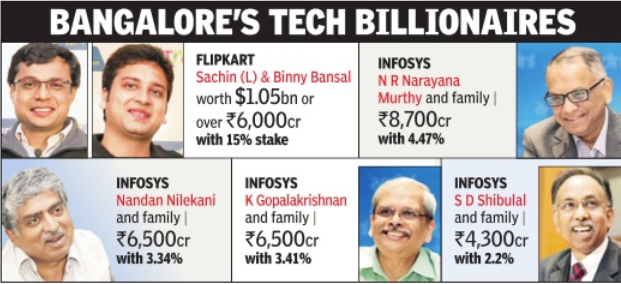
2014: Indians abroad/ Diaspora
The UK
2014 Hinduja brothers among UK's top 3 richest families
Kounteya Sinha,TNN | Mar 17, 2014
London-based Indian family - Srichand and Gopichand Hinduja of the Hinduja Group, a multinational conglomerate with a presence in 37 countries with businesses as diverse as trucks and lubricants to banking and healthcare, are among the five richest families in the UK which have together amassed more wealth than 20% of entire British population.
Together worth $10 billion, the Hinduja family along with four other British families have been shown to have more wealth than 12 million poorest Brits.
Britain's five wealthiest people boast a collective worth of £28.2 billion, while the total accumulated by the bottom 20% sat at £28.1 billion.
2014: Indians with over $100m
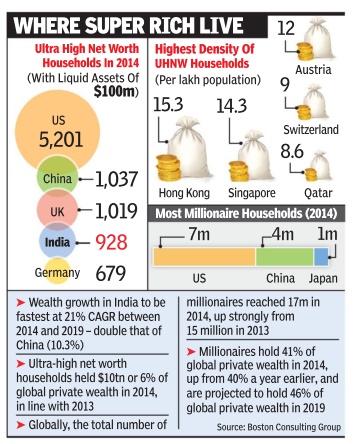
The Times of India, Jun 17 2015
India ranks 4th globally in 2014, says report
No. of Indians with over $100m hits 928
The number of ultra high net worth (UHNW) individuals in India has more than trebled to 928 in 2014 from 284 in 2013, according to a Boston Consulting Group (BCG) report.Though BCG has clarified that the two figures cannot be compared because there has been a change in methodology , following the new study , India's ranking among countries in terms of the number of UHNW individuals has risen to number four in 2014 from the 13th position in 2013. The report defines individuals with financial wealth (excluding residential properties) of $100 million (Rs 640 crore) as UHNW . BCG executives said, “Currency impacts versus the US dollar (our segments are in US dollars) and methodological changes to the national accounts' data make a comparison between the 2014 and 2015 reports very difficult.“ Going by 2015 methodology , UHNW individuals in India have increased to 928 in 2014 from 800 in 2013.
According to BCG, the Asia-Pacific region will be the main driver of increase in global wealth, fuelled by the rich in China and India.What's more, wealth in India is projected to record the fastest growth of 21% between 2014 and 2019 -double the growth rate of the next fastest wealth creator China (10.3%).
In its 2015 wealth report called `Winning the Growth Game', BCG has said that private wealth in China and India showed solid market gains, driven mainly by investments in local equities. China's equity market rose by 38% and India's by 23%.
The US remained the country with the largest number of UHNW households at 5,201, followed by China (1,037), the UK (1,019), India (928), and Germa ny (679). The highest density of UHNW households was found in Hong Kong (15.3 per 100,000 households), followed by Singapore (14.3), Austria (12), Switzerland (9), and Qatar (8.6). UHNW households held $10 trillion, or 6%, of global private wealth in 2014, which was in line with 2013. At a projected CAGR of 12% over the next five years, private wealth held by the UHNW segment will grow to an estimated $18 trillion in 2019.
This top segment is expected to be the fastest growing, in both the number of households and total wealth. The number of households in this segment is projected to grow at a CAGR of 19% over the next five years. “With such a large number of households entering this segment, the average wealth per household is pro jected to decline at a CAGR of 6%,“ the report said.
Private wealth held by the upper high net worth (HNW) segment (those with between $20 million and $100 million) rose by a healthy 34% in 2014 to $9 trillion. Private wealth held by the lower HNW segment (those with between $1 million and $20 million) is expected to grow at a slightly lower rate (7%) over the next five years.
Globally , the total number of millionaire households (those with more than $1 million in private wealth) reached 17 million in 2014, up strongly from 15 million in 2013. The increase was driven primarily by the solid market performance of existing assets, in both the new and old worlds.
2014: Hurun: India Rich List (top 100)
See Rich List: India, 2014: Hurun
The difference between the two Hurun Lists for 2014 is that the first list (mentioned above) was for the whole world and was issued earlier in 2014; Indian names were extracted from the global list, with their global as well as Indian ranks. This, the second list, was issued later in the year, by when some figures had changed, was India-specific and had more Indian names.
2014: 11th most millionaires: World Wealth Report
The Times of India, Sep 16 2015
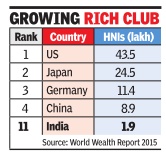
India saw its millionaires' wealth grow most in 2014 India has become home to 11th largest population of millionaires with 1.98 lakh such high net worth individuals (HNIs), as falling oil prices and “constructive“ election results helped the country post the biggest gains in erms of their number and otal wealth during 2014. India recorded the largest gains -for the region and globally -for HNIs population 26.3%) and wealth (28.2%).
“The election of a popu ar reform-minded Prime Minister helped to boost inves or confidence and contributed to strong performance in he stock market, with a 21.9% increase in the MSCI index. Lower oil prices helped reduce country's budget deficit and retail inflation fell considerably . All these events helped India moved up to third place for HNIs' wealth across Asia-Pacific, displacing Australia, which suffered from a significant 7.6% decline in equity markets,“ it added. According to the World Wealth Report 2015, released by Capgemini and RBC Wealth Management, there were 1,98,000 HNIs in India in 2014, while in 2013 the figure stood at 1,56,000.
India has been raked 11th in the list of countries with highest number of HNI po pulation. The US topped the chart with 43,51,000 millionaires, followed by Japan at 24,52,000, Germany (11,41,000) and China (8,90,000).
The top four countries account for 60.3%t of the total worldwide HNI population. Globally in 2014, strong economic and equity market performance helped to create 920,000 new millionaires. The number of HNIs grew to 14.6 million, while their collective wealth surged to $56.4 trillion.
Since 2006, Asia-Pacific dominated HNI growth and of the $7.4 trillion of HNI wealth added in Asia Pacific since 2006, India and China accounted for an impressive 43%.“Continued growth is expected to result in India and China holding over 10% of all global HNI wealth by 2017,“ the report said.
2015
2015, Forbes: India no.4
See Rich List: India, 2015: Forbes
This list was released in March 2015; therefore, it mainly pertains to 2014.
2015, February: Sanghvi is no. 1
The Times of India Feb 20 2015
Partha Sinha
Dilip Shanghvi, the 59-year-old promoter of Sun Pharma, appears to have overtaken Mukesh Ambani (57) of Reliance Industries Ltd as the richest Indian if one goes by promoter holdings in the listed companies of the two groups. The Gujaratborn and Kolkata-educated Shanghvi, by virtue of his over 63% holding in three companies -Sun Pharma, Sun Pharma Advanced Re search and Ranbaxy Labs -is worth about Rs 1.46 lakh crore ($23.42 billion at an exchange rate of 62.34 per dollar).
In comparison, Ambani, through his 45% holdings in two group companies -RIL and Reliance Industrial Infrastructure -was worth Rs 1.32 lakh crore ($21.2 billion), according to data compiled by TOI from the Bombay Stock Exchange (BSE).
If one adds the 23% stake in wind energy major Su zlon, that Shanghvi and his family is in the process of acquiring, his wealth would be nearly Rs 1.48 lakh crore ($23.7 billion).
However, Bloom berg's Billionaire Index still ranks the RIL boss as the richest Indian and 33rd globally with a net worth of $21.9 bn, and Sanghvi as the second richest (39th globally) at $19.7 bn, ahead of Azim Premji ($18 bn) and Pallonji Mistry (16.6 bn). In the last one year the Sun Pharma stock has gained 50% to become the most valued pharmaceuticals company in India and one of the top five in the world. As a result Shanghvi, who started the company in 1982 with a seed capital of Rs 10,000, has become the richest drug maker in the world.
His fortunes were also boosted by his acquisition of Ranbaxy Labs from its Japanese owners and sharp gains in Sun Pharma Ad vanced Research, the group drug R&D arm that was hived off as a separate company from the group's flagship a few years ago. In the last one month, while the Sun Pharma stock has gained about 5% to its current price of Rs 918, Sun Pharma Advanced Research jumped 50% to Rs 374. Ranbaxy too has gained about 10% to Rs 709 to add to Sanghvi's wealth at a fast clip.
During the same period, RIL has gained about 3% while Reliance Industrial Infra has fallen marginally .
According to Hurun India rich list published last year, Ambani held on to his position as the richest man in India with a fortune of Rs 1.65 lakh crore, up 37% from last year.Shangvi shot up to No 2, overtaking L N Mittal for the first time, after seeing his wealth grow 43% to Rs 1.29 lakh crore.
2015, March: Forbes’ update
Two days after publishing its rich list for 2015, a Forbes’ 'real time' update on 4 March 2015 ranked Shanghvi the richest Indian (global rank: 37/ $21.5 b), with Mukesh Ambani ($20.4 b) at no.2 (global rank: 43) and Azim Premji at no.3 (global rank: 47) among Indians.

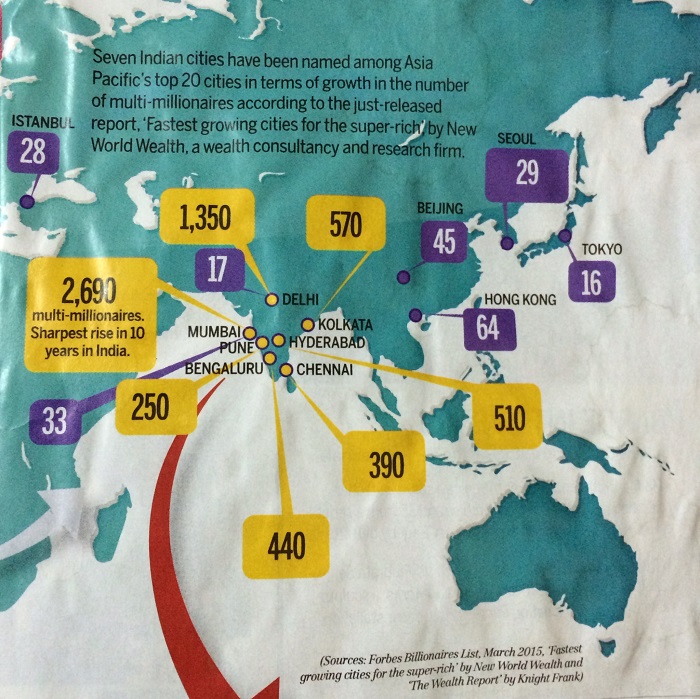
Sept 2015: Hurun's India Rich List
See Rich List: India, 2015: Hurun
2015: UK regional Asian rich list
The Times of India, May 19 2015
An Indian-origin entrepreneur nicknamed `Chicken King' for running UK's largest poultry business has topped the Asian Rich List for the Midlands region of England with an estimated wealth of £1.35 billion. Ranjit Boparan, the founder and owner of 2 Sisters Food Group, has topped the Asian Rich List -Midlands, published by the Asian Media & Marketing Group (AMG), for a second consecutive year with an overall increase of £50 million over 2014. Leading NRI industrialists Lord Swraj Paul and his son Angad, whose Caparo Group has significant business presence in the Midlands region north of London, was ranked second with an estimated £725 million.
Vedanta Resources founder-chairman Anil Agarwal (£370million), Abdul Rashid and Aziz Tayub (£200million) of the wholesale Crown Crest Group and Shiraz Tejani (£150million) of the manufacturing group LPC complete the year's top five. “The list shows the remarkable resilience and diversity of Asian businesses in the UK. Despite the challenges of the general economy many business leaders in the community have seen opportunity and potential and moved quickly to capitalize.
“It is an inspiring picture and one that should energise entrepreneurs everywhere,“ said Shailesh Solanki, executive editor of AMG and one of a panel of four experts who examined British Asian wealth.
June 2015: Billionaires from Kerala
The Times of India, Jun 04 2015
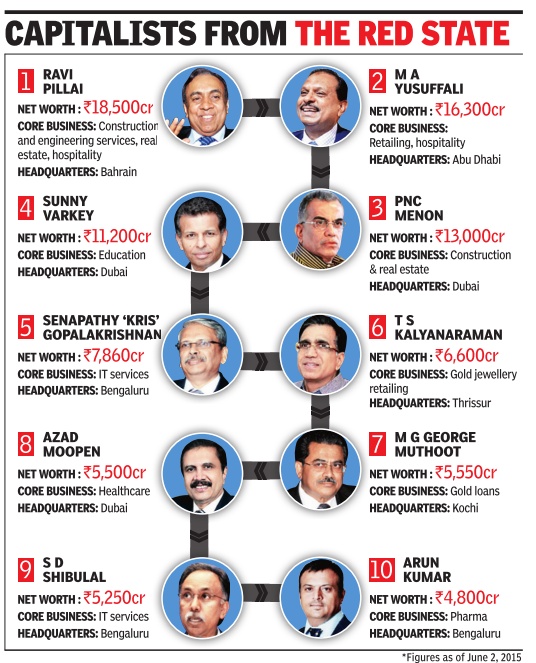
Shenoy Karun
THE TOP 10: WORLD'S RICHEST MALAYALIS - Billionaires from the Backwaters
Kerala is not just God's own country, where tourism and tradition define its global appeal. Wealth and entrepreneurship also distinguish Malayalis on the global map. The Times of India brings you a list of the 10 richest Malayalis on the basis of their net worth
Even as his wealth has multiplied, M A Yus suffali, the world's second-richest Ma layali with headquarters in Abu Dhabi and a net worth of about Rs16,300 crore, makes it a point to stay connected to his small-town roots.His 113 hypermarkets spread across nine countries rake in around Rs37,000 crore annually .“Around 24,000 out of 32,000 employees are from Kerala; 4,000 are from my own village Nattika,“ Yusuffali says. “Do you know that I don't have to pay for fish back in my native village? I have given jobs to the youth from all communities, some of whom are from fishermen's families.So, when I'm around, their parents always make sure that I get fresh fish.“ A unique aspect is the composition of this rich list--it cuts across religions. Many in the list, including the top three, are self-made. Coming from a milieu where money-making was almost considered a sin, their small trader background was often their only capital when they started. The list of the 10 richest Malayalis is as diverse as it is impressive. The core businesses of these magnates range from construction, retail and jewellery to education, banking and software.
Billionaires rarely talk about their wealth. Almost all the businessmen on our original shortlist were happy to speak to TOI until we started asking them about their personal wealth. One of them deflected us by saying, “I didn't worry about riches as long as I have appam and egg curry on my breakfast table.“
That made our life a lot more difficult, because most of them own either private or closelyheld companies which are not listed on stock exchanges and therefore do not lend themselves to ready estimates of their market value. So, our Malayali rich list is born not out of any one standardized methodology but a mix of valuation processes like street or stock market value, and peer comparison. We also relied on company data; interviews with promoters, competitors, investors and analysts; and background checks. In cases where we could not get the exact value of wealth, we have tried to arrive at its fair value (please see accompanying report on methodology). Our calculations also do not take into account assets such as private residential properties and art collections. They are, at best, ballpark estimates. But they do convey a sense of what our richlisters are worth.
Emirs From Kerala
Ravi Pillai, chairman of the Bahrain-headquartered RP Group, tops the list with a net worth of Rs18,500 crore (see Top 10); much of the wealth of this construction tycoon comes from the profits of Nasser S AlHajri Corporation (NSH), a company he founded in 1978 in Saudi Arabia. Says Pillai, “I was a contractor with public enterprises in Kerala before I came to the Middle East. A strike at one of the undertakings forced me to look for opportunity elsewhere. Of the 500 people working with me, I took 200 to Saudi Arabia. If the strike hadn't happened, I wouldn't have made my fortune.“ Half of those who figure in the Top 10 made their fortunes in the Middle East in the 1970s. Partly , this has to do with the fact that despite new-found oil reserves, the region was quite backward then and lacked local initiative.
Yusuffali created a retail empire that originated in the UAE. He recalls those early days: “I landed in Dubai in a ship named Dumra on December 31, 1973. I found Abu Dhabi a town without a steady supply of electricity or a proper sewage system. Whenever temperatures rose sometimes up to 52 degree Celsius, along with 84% humidity we used to sleep on the roof.“
Pillai is a first-generation entrepreneur with roots in Chavara, near Kollam; his parents were farmers. Between NSH and 25 other companies he owns, they generate revenues of Rs26,800 crore annually. Other than construction, Pillai has a strong presence in travel and tourism, healthcare and education, mainly in India and the Middle East.
Often called 'Ambani of the Gulf', Pillai shot into limelight when he acquired Leela Resorts in Kovalam from the Mumbaibased family of C P Krishnan Nair, who was for decades one of the best-known faces of Malayali entrepreneurship. (For the last few years Capt Nair's elder son Vivek has been working hard to reduce the group's large debt burden.) P N C Menon is the thirdrichest Malayali in the world with a net worth of Rs13,000 crore. His holding company, the Dubai-headquartered PNC Investments, generated revenues of 1.2 billion dirham (Rs2,107 crore) during 2013, with net profits of 88.4 million Dhs (Rs150crore). Having lost his father when he was 10, Menon discontinued college to become an interior designer at Thrissur where his father once ran a small business. One day in 1976 his fortunes changed when he met Brig Gen Suleiman Al-Adawi from Oman in the lobby of a Kochi hotel. The general invited him to Muscat where the duo founded an interior design firm with a bank loan of 3,000 riyals. Talk of the right connection!
Small Towns, Big Dreams
Yusuffali's companies gen e r a t e d r eve n u e s o f Rs37,000 crore in 2014. He learnt the tricks of the trade during his four-year stay in Ahmedabad, where his paternal uncle ran a general store. In 1973, he moved to Abu Dhabi where his father and uncle ran MK Stores, a kirana shop. “In 1983 came my first foreign trip.With 10 years of experience in retailing, I went to Singapore, Sydney , Brisbane, Melbourne and Perth. Australia's supermarkets impressed me the most. I decided to set up big supermarkets in Abu Dhabi instead of small grocery shops,“ Yusuffali says.
Running In The Family
Their businesses couldn't be more different but a common thread unites T S Kalyanaraman, George Muthoot and Sunny Varkey their families gave them a foundation on which to build their futures.
Varkey , who has a net worth of Rs11,200 crore, is fourth on the list. A second-generation entrepreneur, Varkey came to Dubai in 1959 at the age of two along with his banker father.During their free time, his parents gave English lessons to workers; their efforts culminated in a formal school Our Own English High School.When his father retired in 1980, Varkey took over the reins of the organisation and started expanding, spurred by the belief that there was a huge potential for quality education not only in the Middle East, or on the subcontinent, but also in developed countries. His company Gems Education, headquartered in Dubai, operates a global network of schools and pre-schools in the Middle East, Africa, various parts of Asia, the UK and the US.
A third-generation businessman, Kalyanaraman started helping his father right from school, in the family's textile business. In 1993, he ventured into gold jewellery retail, which pushed him into the list of billionaires. As chairman and MD of the Thrissur-headquartered Kalyan Jewellers, Kalyanaraman is sixth in the list with an estimated net worth of Rs6,600 crore. His company generated revenues of Rs 7,400 crore in 2014. During that time, private equity firm Warburg Pincus invested Rs 1,200 crore in the company for a minority stake.T he company now has 77 stores in India, the UAE and Kuwait, and plans to open 16 more by March 2016. Says Kalya naraman, “I never expected to be rich like this. While I first started a jewellery showroom in 1993, I was using an Ambassador. Then, I used a Maruti 800. Now, between me and my two sons, we own three Rolls Royces“. And then are his private jets (but more of that later).
M G George Muthoot, chairman of Muthoot Group, takes seventh position with a net worth of Rs5,550 crore. Between Muthoot and his 12 family members, they own 29.8 crore shares of Muthoot Finance, the largest gold loan company in the country . Muthoot is a thirdgeneration businessman with origins in Kozhencherry, a small town south-east of Kochi, where his group is headquartered. A graduate in mechanical engineering from the Manipal Institute of Technology , he entered the business in the 1970s. The group has since spread into education, healthcare, IT, plantations, travel and tourism, and power generation.In Kerala, gold loans have become synonymous with Muthoot Finance.
Class Act
Senapathy`Kris' Gopala krishnan, co-founder and one-time CEO of Infosys, India's second-larg est software firm, is the fifthrichest Malayali. Along with wife Sudha and daughter Meghana, he holds more than 3.9 crore shares of the company , with an estimated market cap of Rs7,860 crore. A graduate in physics from the University of Kerala, Gopalakrishan did his master's in computer science at the Indian Institute of TechnologyMadras.
Like Gopalakrishnan, S D Shibulal, another co-founder of Infosys (and the last of the owner-CEOs), comes in ninth in the rich list with a net worth of Rs5,250 crore. He, too, is a product of the University of Kerala, where he did his master's in physics. In Shibulal's case, the street value of his 2.3 crore shares of Infosys and that of his wife and children have been added up to calculate his net worth, along with the value of his more than 700 apartments in the US.
Azad Moopen, chairman of the Dubai-headquartered Aster DM Healthcare LLC, is in the eighth position with a net worth of Rs5,500 crore. An MB BS gold medallist, he started his career as a lecturer at the Cali cut Medical College in 1982 before arriving in Dubai five years later. Aster Group now operates close to 260 hospitals and pharmacies in the Middle East and India. Moopen also owns a medical college in Wayanad district of Kerala. Moopen told TOI, “Everybody in my family , including my father and brothers, have been in business. I was an exception; I went into academics.“ But clearly , business ran in his blood, too.
In tenth position is Arun Kumar, founder and group CEO of Strides Arcolab, a pharma company . With roots in Kollam district, he was brought up in Ooty , worked in Mumbai, and shifted the headquarters of the company he founded 25 years ago to Bengaluru. In 2013, his company sold Agila Specialties, one of its divisions, to US pharma giant Mylan for $1.75 billion.According to industry sources, he has sold businesses worth $2.2 billion in the past three years. His personal net worth is estimated at Rs4,800 crore. He still controls Strides Arcolab, along with Sequent Scientific and Alivira Animal Health. Agnus Capital, his family's investment vehicle, has stakes in a number of high-value start-ups.
Sprawling Empires
The scale of operations of the Malayali barons from the Middle East is immense. Some of them operate in almost all continents. It is estimated that nearly 7.1 lakh customers walk into Yusuffali's Lulu hypermarkets daily, mainly in the Middle East. His company sources from 51 countries and has set up procurement offices in 36 nations around the world. Likewise, Ravi Pillai also operates across a vast geography from Africa to Australia, employing 90,000 people. “Within two months, we'll have 1 lakh employees as we are recruiting 10,000 workers for our projects in Kuwait,“ says Pillai.
They may not be deliber ately ostentatious but all these magnates live luxuriously and peripatetically.Yusuffali's staff keeps 40 cars, including a fleet of Rolls Royces, BMWs and Mercedes-Benzes, and a private executive jet Embraer Legacy 650 waiting for him in Dubai or Kochi. And wherever needed, he rents helicopters locally for short trips. Apart from residential homes in Abu Dhabi, London and Kochi, he owns commercial properties in London, Muscat, Doha, Mumbai and New Delhi. Kalyanaraman owns two jets, an Embraer Phenom 100 and an Embraer Legacy 650, as well as a Bell 427 helicopter, which allow him to hop between his stores.
2015: New wealth builders: 2010-14
The Times of India, Sep 24 2015
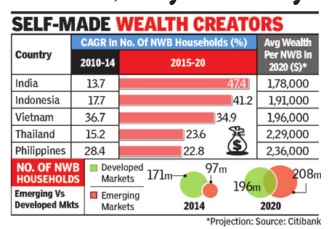
No. of new rich to grow fastest in India, says study
Mayur Shetty The number of new rich in India will almost double over the next five years, posting the fastest growth of 47%, a latest study says. In comparison, the number of such individuals with a wealth of over $1,00,000 will grow 7% globally and 10% in Asia by 2020, the study says. The study , conducted by EIU and commissioned by Citibank, for the first time focuses on new wealth builders (NWBs) -a term used to describe self-made individuals who are either salaried, self-employed professionals or entrepreneurs in new-age startups. In India, the number of such new wealth builders is expected to be close to five crore and the total value of their financial assets is expected to be $879 billion in 2020 -almost double of what it was a decade ago.
According to the report, the NWBs represent a new breed of self-generated success, are humble and focus on making progress for those around them. “Nearly eight in 10 NWBs acquired most of their wealth in the past 10 years. Almost none attribute current wealth to inheritance,“ the report said.
According to Kartik Kaushik, Citi India global head of consumer banking, two additional trends for India were that there was a very high savings rate and a majority of them would be young -in their mid-20s to 30s. He said the growth of this segment provides a big opportunity for banks like Citi. “Until now we had nothing in between Suvidha, Citibanking and Citi Gold.To address this category, we are launching Citi Priority as an integrated offering for those who maintain a Rs 15 lakh relationship with the bank,“ said Kaushik. He explained that this was not a bundling of separate services but a comprehensive product where the customer gets debit card, credit card and other services as part of the offering.
Flight of capitalists
2015: India no.4
The Times of India, Mar 30, 2016
4,000 Indian millionaires shifted overseas in 2015, report says
India has seen the fourth-biggest outflow of high net worth individuals globally in 2015 with shifting of 4,000 millionaires overseas, says a report.
According to a report by New World Wealth, some 4,000 uber-rich Indians have changed their domicile in 2015, while France saw the maximum outflow of millionaires with as many as 10,000 super rich leaving the country.
The report however noted that the migration of super rich from China and India is not a "concern".
"The outflows from India and China are not particularly concerning as these countries are still producing far more new millionaires than they are losing," the report said and added that "once the standard of living in these countries improves, we expect several wealthy people to move back."
In terms of countries ranked by millionaires outflow, France was followed by China in the second place with 9,000 millionaires leaving the country while for Italy, at third position, the figure stood at 6,000.
In terms of millionaire inflows, Australia topped the chart as it saw as many as 8,000 uber rich people shifting base there, followed by the US (7,000) and Canada (5,000) in the second and third place respectively.
Millionaires, otherwise known as "high net-worth individuals" or "HNWIs" refer to individuals with net assets of $1 million or more excluding their primary residences.
Sportsmen
See graphic

The highest paid actors
See Rich list of film artistes: India
2016
2016: Hurun Global Rich List
The Hindu, February 25, 2016
India adds 27 new billionaires
Worldwide, 99 new billionaires were added to the Hurun Global Rich List 2016.
India added 27 new billionaires with Mukesh Ambani, Chairman of Reliance Industries (RIL), emerging at the top with a personal wealth of $26 billion, according to Hurun Global Rich List 2016.
Cumulative Indian billionaires’ wealth stood at $308 billion, registering a 25 per cent growth over last year. Mr. Ambani, who is ranked 21st globally, was followed by Sun Pharma promoter, Dilip Shanghvi , with personal wealth of $18 billion.
India is home to 111 billionaires and most of them are from Mumbai, according to the report.
Globally, 99 new billionaires were added to the list in 2016 to take the total billionaire rich list to a record of 2,188, 50 per cent more than 2013. Hurun Report released the Hurun Global Rich List 2016, a ranking of the US dollar billionaires currently found in the world.
The UK/ The Sunday Times
The Times of India, Apr 25 2016
India-born Reuben bros top UK rich list with £13.1 bn fortune
Britain's annual rich list released on Sunday has a distinctly Indian flavour with two sets of Indiaborn brothers -Reuben and the Hinduja -grabbing the top two slots.Mumbai-born tycoons David and Simon Reuben have topped `The Sunday Times' Rich List 2016 with a fortune of £13.1 billion, followed by the Hinduja brothers at £13 billion.
The Reubens were born in India to a wealthy Iraqi-Jewish family before moving to Britain in the 1950's and made their fortune in metals and property . This year, they have increased their fortune by £3.4 billion to jump to the top slot from last year's fifth position.
Their collection of London property includes Millbank Tower, the John Lewis Partnership HQ in Victoria and shops in Sloane Street. The list goes on. They own London Oxford Airport and London Heliport and were a leading investor in Metro Bank, which floated last month at £1.6 billion,“ the newspaper notes.
“Famously wary of debt, David, 77, and Simon, 74, keep a large proportion of their wealth in liquid assets, such as cash and bonds, and cautiously value their properties at cost. Overseas property and a metals operation add £300 million, while the hidden value in their London portfolio and their Global Switch stake take the Reubens, who live in Switzerland, to £13.1 billion,“ the newspaper adds.
Srichand and Gopichand Hinduja, who head the Hinduja Group, hold on to their second rank from last year with an unchanged fortune.
“The old War Office in London's Whitehall was bought for £300 million by the Hinduja family in March on a 250-year lease. They plan to turn it into a hotel worth £1 billion,“ it noted. However, another Indian tycoon did not have a similarly fruitful year with Lakshmi N Mittal's steel empire taking a hit from the global industry crisis and losing nearly threequarters of his wealth.
The 65-year-old ArcelorMittal chief held the top slot on the list back in 2008 with a £27.7 billion, which is now down to just £7.12 billion this year. He slips to 11th on the list from 7th last year.
“The guys at the top who are feeling the pain this year are often hit by a cocktail of plunging stock markets, low oil prices and the crisis in the steel industry -sometimes by all three,“ said Robert Watts, compiler of the 2016 list.
NRI steel tycoon Lord Swraj Paul and family are also among those hit by the steel crisis, with their fortune registering a 66% drop to £740 million, to be ranked 154th this year compared to 44th in 2015.
“The turmoil in the steel industry hit Paul's Caparo business last autumn when 16 of its companies went into administration. Most of the firms and jobs were saved by Sanjeev Gupta, who is interested in the Port Talbot steel complex. Indian-born Paul, 85, gives generously to charity ,“ the rich list reads. Completing this year's top three is Warner Music owner Len Blavatnik, who has £11.59 billion.
The UK has clocked 120 billionaires in 2016, the highest recorded since 2006, but the number of London billionaires fell for the first time since the financial crash -from 80 in 2015 to 77.
On the global scale, India has a record 56 billionaires, compared to 193 in China and 43 in Russia. In a linked analysis of the `50 Richest in the World', Reliance brothers Mukesh and Anil Ambani have been jointly ranked 30 with a fortune of £17.9 billion.
Brothers related to Mumbai's Baghdadi Jews
One of the leading Baghdadi Jews of Mumbai, Solomon Sopher, happens to be the first cousin of Simon and David Reuben. “They are the sons of my mother's brother,“ Sopher said on Sunday. “In fact today is the Jewish festival of Passover and I received an SMS greeting from them a few minutes before.“ The Reuben brothers had modest beginnings in Byculla and studied at the Jacob Sassoon high school run by the community. Simon turns 75 on May 20 while Reuben David is two years older. The elder sibling studied in VJTI. “I am so proud of them. They represent the small but industrious community of Baghdadi Jews, and of course, because we are cousins, I know that they rose steadily by the dint of hard work. Their father was a businessman so they inherited his genes for diligence and toil,“ says Sopher. Sopher mentioned them to Briatin's prince Charles when he arrived in Mumbai in the 1980s. “I said do you know the Reuben brothers? Prince Charles said, `Simon is my good friend',“ laughs Sopher. The brothers did not return to Mumbai after they left given that their father passed away in 1961. They do have business interests in Chennai, though.They often shuttle between France and London. Sopher is their closest of kin in Mumbai. He met them in 2015 when he travelled to attend the Royal Ascot where he has racehorses.
2017
The Karnataka rich list
Shenoy Karun & Sujit John, Jan 8, 2017: The Times of India
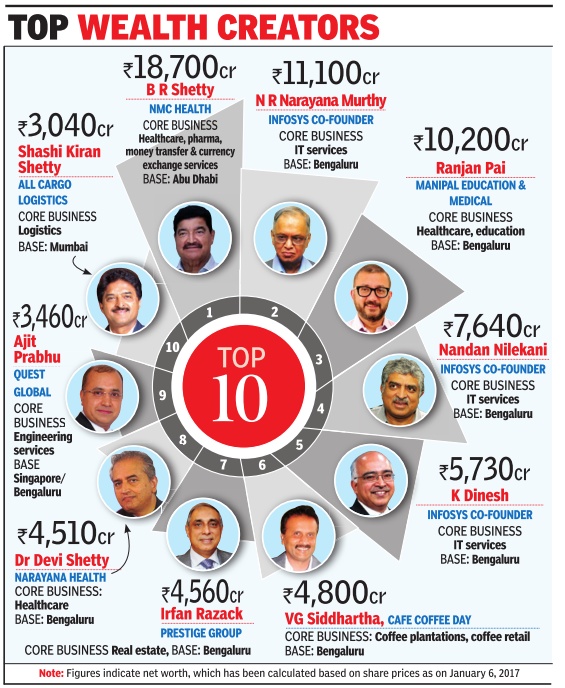
Many on this rich list built their fortunes in post-liberalized India riding on the huge opportunities that came their way with the opening up of the economy. This is especially true for the tech billionaires. A few others, mainly those in real estate and health, benefited from the rise of the professional class with high disposable incomes
Four of us used to sleep in one room. Can you imagine that -in a 10ftx12ft room, with no air conditioner or fan! It was a marshy area and every morning we had to clear the water that had seeped in before doing anything else. It was like a Badu (Arabic for Bedouin, a nomadic group) house,“ reminisces B R Shetty , the richest Kannadiga in the world, about his days as a 31-year-old job seeker in Abu Dhabi in UAE.
Today, 40 years later, Shetty owns the entire 100th floor -15,000sqft -of Burj Khalifa, the tallest building in the world, and one of the plushest. “I also own flats on a couple of other floors in the same building,“ he says. He owns residential buildings in Dubai, Abu Dhabi, London, Perth, Bengaluru, Mangaluru and Udupi.
This one-time job seeker now employs 38,000 people, mainly in the Middle East. His NMC Health is UAE's largest private healthcare provider, and his UAE Exchange is a leading global remittance and foreign exchange brand that bought the London-headquartered foreign exchange group Travelex for £1 billion two years ago.
Tulu-speaking Shetty, 72, has a net worth of Rs 18,700 crore, or about $2.75 billion. His only son got married last week in Mangalore, his hometown. It attracted the entire political top brass of the state. He is the only one among the ten on the TOI Rich List of Kannadigas who has built his fortune outside the country . Eight started their businesses within their home state, and most are first-generation entrepreneurs or have built their businesses from scratch. We must clarify that since this is a list based on linguistic communities of the state, and not a list of the richest people who live in Karnataka at the moment, we are including those who speak not just Kannada, but other languages prominent in the state, including Tulu and Konkani, and anybody whose family has a history of at least 100 years in Karnataka.
So the No. 2 on our list is Infosys co-founder N R Narayana Murthy, with a net worth of Rs 11,100 crore, or about $1.6 billion. Murthy is one of the IT outsourcing pioneers of India and can justifiably lay claim to some of the enormous global attention that India in general and Bengaluru in particular receives.
Murthy was born in Sidlaghatta in Kolar district and grew up in Mysuru where his father was a high school teacher. After completing his school education, he went to National Institute of Engineering, Mysuru, from where he graduated in 1967 with a degree in electrical engineering. He then did a Master's degree at IIT Kanpur.
Murthy was a strong leftist in his early days but, after a humiliating experience at the hands of communist Bulgaria's police during a train ride, renounced those beliefs in favour of what he today calls “compassionate capitalism“.
He became convinced that the answer to India's underdevelopment lay in entrepreneurship. Spotting an opportunity in creating bespoke software for US clients using India's substantial engineering talent, he founded Infosys in 1981 with six others.This pioneering IT services company is now one of India's most valued, and has made billionaires, or near-billionaires, of all its founders.
Two of Murthy's fellow co-founders -Nandan Nilekani and K Dinesh -feature in our list at Nos 4 and 5 respectively . Nilekani and family's net worth stands at about Rs 7,640 crore, and Dinesh and family's at about Rs 5,730 crore.
Nilekani was born in Bengaluru and attended Bishop Cotton Boys' School before studying electrical engineering at IIT Bombay . He had an outstanding stint as Infosys CEO between 2002 and 2007. Two years later, he left Infosys to serve as the chairman of the Unique Identification Authority of India (UIDAI), a cabinet-rank position. Nilekani is now also on the Niti Aayog panel on e-payments, working with chief ministers to promote the use of digital payment systems across the country .
Immediately following Murthy at No. 3 on the TOI Rich List, is a man who has built on an education and healthcare business he inherited Ranjan Pai. His grandfather, T M A Pai, started Kasturba Medical College in Manipal in 1953 and Manipal Institute of Technology (where Microsoft CEO Satya Nadella graduated from) five years later. His father, Ramdas Pai, took it further.
All of that is now part of Manipal University .But Ranjan Pai, 43, has massively expanded the business and given it a corporate structure, inspired partly by what he saw in the US when he went to study hospital administration at the University of Wisconsin-Madison.
He's made some aggressive acquisitions. His Manipal Education and Medical Global owns and operates university campuses in Malaysia, Antigua, Dubai and Nepal. It owns and operates a chain of 15 hospitals in India and overseas. We estimate that all of these together will put Pai's wealth at Rs 10,200 crore, or $1.5 billion.
Sixth on our list is V G Siddhartha, whose family owned coffee plantations in Chikamagaluru and exported the coffee they grew. Siddhartha wasn't keen on the laid-back life of a coffee planter, so early in life, he focused on the stock market. Some of the money he earned was used to buy more coffee plantations and by 1995, he had become India's biggest coffee exporter. By the mid-1990s, he had begun to wonder how he could add value to his coffee.
On a visit to Singapore, he happened to see people in a cafe sipping beer and browsing the internet. “I thought this was an idea that could work in Bengaluru as the city had just begun to see the emergence of software companies with young professionals,“ Siddhartha says. The first outlet came up in 1996 on Brigade Road in Bengaluru; today there are 1,650 across the country -no other cafe chain comes anywhere close. Siddhartha also owns and manages more than 15,000 acres of coffee plantations and has major investments in tech companies, including Mindtree.
The 7th richest is also perhaps the biggest property developer in south India today -Irfan Razack. His great-grandfather had moved to Bengaluru from Kutch. The entrepreneurial story of this family began not with real estate, but with a small store for men's clothing on Bengaluru's Commercial Street. Razack's father opened the store, Prestige House for Men, in 1957. Razack joined that business after finishing college.
The interest in real estate started in 1981, when the family sold its ancestral property on Infantry Road. Encouraged by the money they made and the learnings from that experience, the family started buying and selling land in Bengaluru. In 1985, the government brought in tax rules that made land trading difficult. So the family moved to real estate development under a company that they called Prestige Estates Projects. Prestige became one of the early companies to exploit the real estate boom that followed the growth of the IT sector in Bengaluru. Irfan, as the eldest of the brothers in the family , leads the company and his stake is valued at over Rs 4,560 crore. At No 8 on our list is Dr Devi Shetty , the cardiac surgeon who founded the healthcare venture Narayana Hrudayalaya. Shetty was born in Mangaluru and resolved to be a doctor when his fifthgrade teacher told the class that a South African surgeon had just performed the world's first heart transplant. He received a Master's degree in surgery from Mysore University in 1982 and then trained in cardiac surgery at Guy's Hospital in England. He returned to India in 1989 to set up the Birla Group's cardiac hospital in Kolkata, the B M Birla Heart Research Centre. In 1989, he performed the first neonatal heart surgery in the country , on a nine-day-old baby . He served as the personal physician of Mother Teresa.
Dr Shetty returned to Karnataka in the 1990s to set up the Manipal Cardiac Centre in Bengaluru. In 2000, he established Narayana Hrudayalaya, a multi-specialty hospital on the outskirts of Bengaluru, with the vision that healthcare costs could be dramatically lowered by adopting economies of scale.
The heart division is said to be the largest in the world with 1,000 beds and performs more than 30 major heart surgeries a day. Shetty is now trying to replicate this model in the Cayman Islands. This industrialization of healthcare prompted the Wall Street Journal to describe Dr Shetty as the Henry Ford of heart surgery . Early last year, Narayana Hrudayalaya was listed on the stock exchange, valuing the company at over $1 billion.
At No 9 is Ajit Prabhu, co-founder of Quest Global, a venture that emerged out of the outsourcing wave pioneered by Infosys and Wipro.Quest was founded by Prabhu and his friend Aravind Melligeri as an outsourced engineering services company in 1997.
The two grew up in Hubbali in Karnataka.Melligeri's father died young, while Prabhu's father used to lease a fruit tree for Rs 2 a day and made money by selling the fruit. They studied in a Kannada medium school, sitting on the floor with slates. Melligeri went on to study engineering at KREC Surathkal and Prabhu at BVB Engineering College in Hubbali. Both then headed to the US for their postgraduation and began working there, Melligeri at Ford and Prabhu at GE. “The first time I spoke English was in the US,“ Prabhu, who now lives in Singapore, once told TOI, Quest counts Rolls-Royce, GE, Pratt & Whitney and Airbus among its clients, and is estimated to have closed 2015-16 with $385 million (approx Rs 2,600 crore) in revenue. The company raised $350 million from American private equity giants Bain Capital and Advent International and Singapore's GIC that is said to have valued Quest at over $1 billion. Prabhu is the primary shareholder in the company now, Melligeri having moved on to focus on an aircraft components manufacturing SEZ in Belagavi.
Rounding up the list is another Shetty , Shashi Kiran. Shettys belong to the Bunt community, traditionally a land-owningfarming community from Dakshina Kannada and Udupi in coastal Karnataka. Bunts are better known nationally for their Bollywood connection, courtesy actors Aishwarya Rai, Shilpa Shetty , Suniel Shetty and director Rohit Shetty . Shashi Kiran Shetty is the founder and executive chairman of Allcargo Logistics, part of the Avvashya Group, India's first multinational player in the logistics sector.
Shetty did his bachelor's degree in commerce at Shri Venkatramana Swamy College in Mangaluru and moved to Mumbai for employment.He started his career in the logistics industry in 1978 with Intermodal Transport and Trading Systems and subsequently moved to Forbes Gokak, a Tata Group company. At 25, Shetty launched a logistics venture called Trans India Freight Services with Rs 25,000.
In 1992, with the idea of creating an integrated logistics service provider, he started Allcargo Logistics. Allcargo is said to be the first company in India to introduce less-than-containerload (LCL) services. In 1995, Allcargo became an agent of Belgium-based ECU Line NV , the world's second largest LCL firm. Ten years later, Allcargo took a 33.8% stake in ECU, and in the following year acquired the entire company . At the time of the takeover, ECU Line's revenue was five times that of Allcargo's. In 2013, Allcargo acquired US-based Econocaribe Consolidators and a controlling stake in Netherlands-based FCL Marine Rotterdam. Today , Shetty's business is spread across 160 countries, connecting several thousand port points.
In 2014, Shetty made national headlines for his purchase of late Bollywood actor Rajesh Khanna's famous Carter Road bungalow in Mumbai, known as Vardan Aashirwaad, for Rs 85 crore, about 3% of his estimated wealth of Rs 3,040 crore.
ORDINARY BEGINNINGS
Three on TOI's rich list -V G Siddhartha, Irfan Razack and Ranjan Pai -were born into reasonable wealth. But for the majority, that wasn't the case. Narayana Murthy's and Dinesh's parents were teachers, and Nandan Nilekani's father was a textile mill manager.
B R Shetty's father was a farmer with political connections, while Ajit Prabhu's dad was a fruitseller. Dr Devi Shetty's and Shashi Kiran Shetty's families were in business in a small way, but they didn't bank on their families to set up their own ventures. TNN
TWO SIGNIFICANT EXCLUSIONS
There are two people who could have been part of this list, but have been kept out given the litigation over many of their assets. The Wadiyars, the royal family of Mysuru, according to some estimates, are worth Rs 30,000 crore, given the prime real estate they hold in Bengaluru, including Palace Grounds, and Mysuru. But the Karnataka government is laying claim to substantial portions of these assets, and the matter is in court.
The second is Vijay Mallya. With his 4% shareholding in United Spirits, 32% in United Breweries and his known properties in India, Africa and Europe, Mallya should have been worth more than Rs 10,000 crore. However, there are ongoing court cases against him, filed by banks and vendors to his Kingfisher Airlines. It is not clear what Mallya will eventually be left with. TNN
WHY PREMJI IS NOT ON THIS LIST
This list is not of the richest people in Karnataka. The idea was to focus on the traditional linguistic communities of the state, those who speak Kannada, Tulu, Kodava and Konkani.This raised the question: Why should we exclude others who came to Karnataka years ago? So we have included anybody whose family has a history of 100 years in Karnataka. Consequently, some of those who are in most rich lists--Wipro's Azim Premji, Biocon's Kiran Mazumdar-Shaw and Infosys co-founders Kris Gopalakrishnan and S D Shibulal--have been excluded from this one.Premji alone, with Rs 85,500 crore, is worth more than the combined wealth of those on this list.
METHODOLOGY
For listed Indian companies, we used the direct valuation method, where the wealth was calculated using `street' or stock market value. In cases where multiple family members held significant number of shares of a company, we estimated the wealth of the family head by combining the shares held by immediate relatives. So, the personal net worth of Infosys co-founders N R Narayana Murthy, Nandan Nilekani and K Dinesh, and of Irfan Razack, Dr Devi Shetty and Ranjan Pai includes the value of the shares held in the respective companies by their immediate family members too.But for valuing promoter wealth of most private companies -where business numbers were not forthcoming -we used the comparable company analysis (CCA) methodol ogy. Hence, we used price-to-earnings (PE) multiples in arriving at a fair value of the wealth these entrepreneurs made over decades. For instance, to estimate Ranjan Pai's holdings in Manipal Global Education Services, an unlisted entity, we multiplied the net profit of Manipal Global Education Services with a PE ratio of 128.80 (current global ratio for educational services) to get a value of Rs 5,383.84 crore. As Ranjan holds 87% shares of the firm, his holdings are worth Rs 4,684 crore. To this we added the recent private equity valuations of his other companies -Manipal Health and Manipal Integrated Services -and also the value of the current holdings of his investment arm, to reach his final net worth of Rs 10,200 crore.For other unlisted companies, we used the same route. Through the price-to-earnings multiple route, we derived the values of B R Shetty's privately-held firms UAE Exchange and Neopharma. Private equity interest, perhaps the most realistic value after street value, was used to arrive at the wealth of Ajit Prabhu's Quest Global. For Narayana Murthy, his wealth includes our estimation of the current value of the private equity holdings of his investment arm.
During the course of the valuation process, we trawled through annual reports, profit and loss accounts, filings with the Ministry of Corporate Affairs and draft prospectuses before reaching a final list. But perhaps the most enriching part of the entire process of valuation was the insights we gained into the minds of these successful people -a peek into their strategies and the scope and scale of their activities across geographies and industries. TNN
A SOCIAL CONSCIENCE
In many communities in India, successful entrepreneurs love to flaunt their wealth. Not so the rich in the Kannadiga list. Vijay Mallya is something of an exception in the state where the wealthy are very low key.
“In a poor society like India, the rich have two major responsibilities. One is to live a simple life shunning vulgar display of wealth so that capitalism becomes more popular and acceptable.Second is to use part of their wealth for making at least a small difference to the lives of the less fortunate ones amongst us,“ believes N R Narayana Murthy of Infosys.
“You should never allow money to affect you as, at the end of the day, it is only about two meals, some comfort and some extra luxury.Money is a by-product of the hard work, integrity, passion and dedication you show in your work,“ says Irfan Razack of Prestige.
In a phone interview, NMC Health's B R Shetty seemed most reluctant to talk about his personal fleet of cars that includes seven Rolls Royces and a Maybach, and the business jet, Gulfstream G450. When asked what wealth means to him, Coffee Day's V G Siddhartha had this to say: “Any additional zeroes to our wealth do not mean anything to us. When we started, we did not think we would create so much wealth. We strongly believe as a family that whatever wealth we earn should be spent for the good of the society.“
Indeed, several on the list have used part of their wealth to establish large and successful philanthropic initiatives. The Infosys co-founders' contributions are well documented.
Rising income inequality
HIGHLIGHTS
The study said there are 84 billionaires in India, with a collective wealth of $248 billion
The CEO of India's top IT firm earns 416 times the salary of a typical employee in his company
Women form 60 per cent of the lowest paid wage labour
In signs of rising income inequality, India's richest one per cent now hold a huge 58 per cent of the country's total wealth -- higher than the global figure of about 50 per cent, a new study showed.
The study, released by rights group Oxfam ahead of the World Economic Forum (WEF) annual meeting here attended by rich and powerful from across the world, showed that just 57 billionaires in India now have same wealth ($ 216 billion) as that of the bottom 70 per cent population of the country. Globally, just 8 billionaires have the same amount of wealth as the poorest 50 per cent of the world population+ . The study said there are 84 billionaires in India, with a collective wealth of $248 billion, led by Mukesh Ambani ($9.3 billion), Dilip Shanghvi ($16.7 billion) and Azim Premji ($15 billion). The total Indian wealth in the country stood at $3.1 trillion.
The total global wealth in the year was $255.7 trillion, of which about $6.5 trillion was held by billionaires, led by Bill Gates ($75 billion), Amancio Ortega ($67 billion) and Warren Buffett ($60.8 billion).
In the report titled 'An economy for the 99 per cent', Oxfam said it is time to build a human economy that benefits everyone, not just the privileged few. It said that since 2015, the richest 1 per cent has owned more wealth than the rest of the planet+ . "Over the next 20 years, 500 people will hand over $2.1 trillion to their heirs -- a sum larger than the GDP of India, a country of 1.3 billion people," Oxfam said. The study findings showed that the poorest half of the world has less wealth than had been previously thought while over the last two decades, the richest 10 per cent of the population in China, Indonesia, Laos, India, Bangladesh and Sri Lanka have seen their share of income increase by more than 15 per cent. On the other hand, the poorest 10 per cent have seen their share of income fall by more than 15 per cent. "Due to a combination of discrimination and working in low-pay sectors, women's wages across Asia are between 70-90 per cent of men's," it said. Referring to the Global Wage Report 2016-17 of the International Labour Organisation (ILO)+ , the study said India suffers from huge gender pay gap and has among the worst levels of gender wage disparity -- men earning more than women in similar jobs -- with the gap exceeding 30 per cent.
In India, women form 60 per cent of the lowest paid wage labour, but only 15 per cent of the highest wage-earners. It means that in India women are not only poorly represented in the top bracket of wage-earners, but also experience wide gender pay gap+ at the bottom. It also said that more than 40 per cent of the 400 million women who live in rural India are involved in agriculture and related activities. However, as women are not recognised as farmers and do not own land, they have limited access to government schemes and credit, restricting their agricultural productivity. The study also said that the CEO of India's top information technology firm earns 416 times the salary of a typical employee in his company. In the US, by contrast, billionaires have frequently chosen to cash out of their businesses, and their wealth has not lasted so long. In Asia, Singapore and India have a high number of multi-generational billionaires and a lot many people across the globe, including India, will transfer wealth to their heirs in the next 20 years, the study said, while pushing for a need to establish a system of inheritance tax. It also referred to the world's largest garment companies that have all been linked to cotton-spinning mills in India, which routinely use the forced labour of girls. "There are evidences against cotton-spinning mills of India, which feed into the world's largest garment companies, using forced labour. As per ILO, there are 5.8 million child labourers in India," it added.
In many parts of the world, corporations are increasingly driven by a single goal -- that is to maximise returns to their shareholders. In the UK, 10 per cent of profits were returned to shareholders in 1970 and this figure is now 70 per cent. "In India, the figure is lower, but is growing rapidly, and for many corporations, it is now higher than 50 per cent. In India, as profits have been rising for the 100 largest listed corporations, the share of net profits going to dividends has also increased steadily over the last decade, reaching 34 per cent in 2014/15, with around 12 private corporations paying more than 50 per cent of their profits as dividends," it said. The report also said the local air pollution caused by burning coal causes around 100,000 premature deaths per year in India. "South-East Asia and India have both substantial coal power development plants and large populations without access to electricity. While coal provides 75 per cent of the nation's electricity, many areas with the densest concentration of coal plants also have the lowest rates of electricity access," it said.
It asked the Indian government to end the extreme concentration of wealth to end poverty, introduce inheritance tax and increase the wealth tax as the proportion of this tax in total tax revenue is one of the lowest in India. "Indian government must eliminate tax exemptions and not further reduce corporate tax rates. Governments must support companies that benefit their workers and society rather than just their shareholders," Oxfam said.
"Indian government must crack down on tax dodging by corporates and rich individuals to end the era of tax havens. Government must generate funds needed to invest in healthcare and education. The government must increase its public expenditure on health from 1 per cent GDP to 3 per cent of GDP and on education from 3 per cent of GDP to 6 per cent," it added.
2,19,000 millionaires in India
India home to 2,19,000 millionaires, says report, November 7, 2017: The Times of India
HIGHLIGHTS
Asia-Pacific remains the global leader in HNWI population and wealth
The Asia-Pacific Wealth Report from Capgemini tracks HNWIs in the Asia-Pacific region
41 per cent of Indian HNWI's financial assets are held outside the home market, the report said
India is home to the fourth largest population of millionaires in the Asia Pacific region with 2,19,000 ultra-rich individuals with a combined wealth of $877 billion, says a report.
According to the 2017 Asia-Pacific Wealth Report (APWR) released today by Capgemini, India stood at fourth position with its contribution of 4 per cent in terms of individual market share in HNWI population growth in APAC (Asia Pacific) region.
High net worth individuals (HNWIs) are defined as those having investible assets of $1 million or more, excluding primary residence, collectibles, consumables, and consumer durables.
At the end of 2016, there were 28,91,000 millionaires in Japan, while China ranked second with 11,29,000 HNWIs and Australia was at the third place had 2,55,000. Between the period 2015-2016, India's HNWI population witnessed a surge by 9.5 per cent, outshining the average annual growth rate of 7.4 per cent of APAC.
"This was ahead of China and Japan which registered a growth of 9.1 per cent and 6.3 per cent, respectively, for the same period," the report noted. In terms of HNWI wealth, India witnessed a double-digit growth of 10 per cent for the period 2015-2016, as compared to the annual average growth of 8.2 per cent.
"After a sedate HNWI wealth expansion of 1.6 per cent in 2015, India posted double digit HNWI wealth growth of 10 per cent in 2016. This jump was propelled mainly by a rebound in its equity markets and real estate...," the report said.
The report further added that "more good news may be on the horizon with improved GDP forecasts for 2017 and 2018 expected to drive further economic growth".
The report further noted that while "in India, investor sentiment has remained cautiously confident in the wake of the election of the reformist Prime Minister Narendra Modi, the unannounced demonetisation initiative challenges in dealing with significant issues such as unemployment, and the ongoing use of retrospective tax grabs on foreign multi-nationals may have caused some trepidation".
For the July-September period of this financial year, the report said that 41 per cent of Indian HNWI's financial assets are held outside the home market.
"In terms of geographic spread of asset allocation, Indian HNWI's are largely holding their assets in Singapore (22.2 per cent) Dubai (14.4 per cent) and London (13.4 per cent).
The report said Asia-Pacific continued to dominate high net worth individual population and wealth, and is on target to surpass $40 trillion in HNWI wealth by 2025.
Asia-Pacific remains the global leader in HNWI population and wealth, but its pace slowed slightly in 2016 with population and wealth increasing 7.4 per cent and 8.2 per cent, respectively, down from 9.4 per cent and 9.9 per cent in 2015.
The Asia-Pacific Wealth Report from Capgemini tracks HNWIs in the Asia-Pacific region, their wealth, and the global and economic conditions that drive change in the wealth management industry.
2018
81,000 crorepatis in India: CBDT; 60% rise
October 22, 2018: The Times of India
India is now home to 81,000 individuals with disclosed income of above Rs 1 crore per annum, with this 'crorepati club' expanding by over two-third in last three years, the Central Board of Direct Taxes (CBDT) data showed.
Releasing key statistics of income tax and direct taxes, the policy-making body of the I-T department said the total number of crorepati taxpayers, which includes corporates, firms, Hindu Undivided Families (HUFs) and individuals, has also seen a growth of about 60 per cent during the same time period.
"The total number of taxpayers (corporates, firms, Hindu undivided families among others) showing income of above Rs 1 crore has registered a sharp increase over the three-year horizon.
"While 88,649 taxpayers had disclosed income above Rs 1 crore in assessment year 2014-15, the figure was 1,40,139 for AY 2017-18, which is a growth of about 60 per cent," the CBDT said.
Similarly, the number of "individual" taxpayers disclosing income above Rs 1 crore had increased during the same period from 48,416 to 81,344, which translated into a growth of 68 per cent.
The latest figures take into account a time period of three years as assessment year 2014-15 has been taken as the base year, a senior official explained.
CBDT chairman Sushil Chandra said these numbers were a result of the Income Tax Department (ITD) putting in a number of legislative, administrative, informative and enforcement efforts over the last few years to educate the taxpayers for paying their due taxes.
He said the department has ushered in a number of technology-enabled non-intrusive methods to check tax evasion and is committed to "widen and deepen" the tax base in the country further.
The latest CBDT data also showed that a growth of more than 80 per cent in the number of returns filed in the last four financial years -- from 3.79 crore in 2013-14 to 6.85 crore in 2017-18.
India's richest 1% got richer by 39%
January 19, 2019: The Times of India
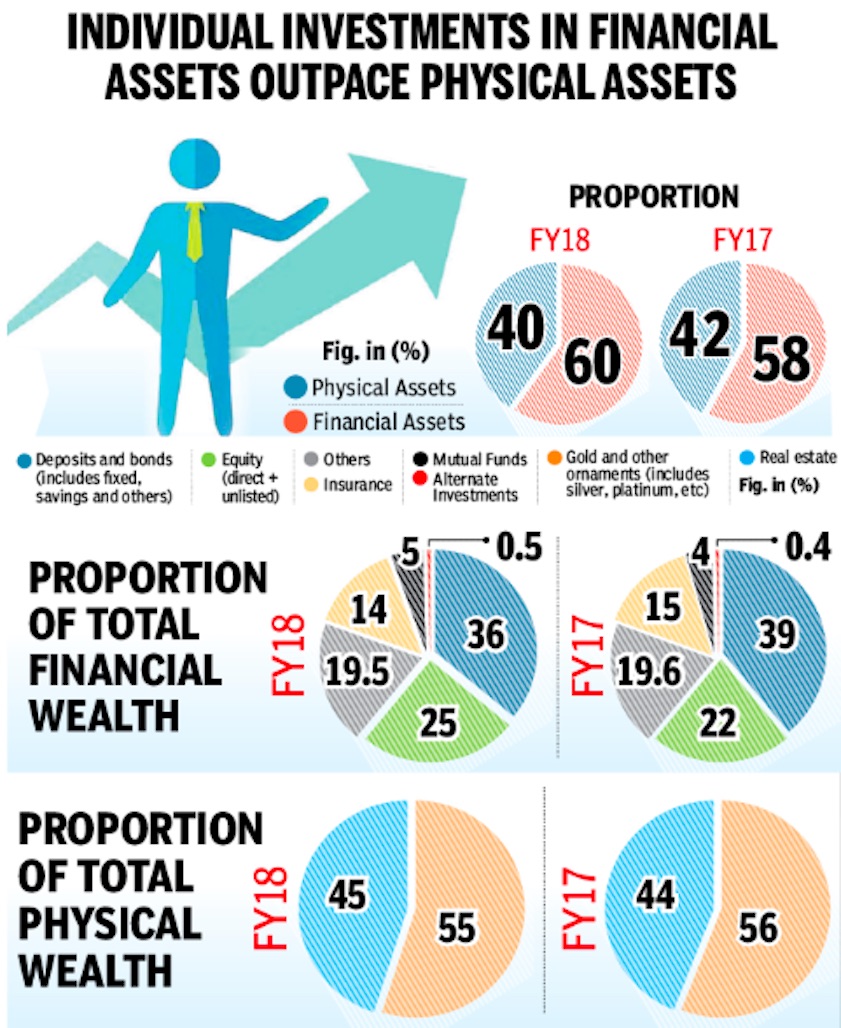
From: January 19, 2019: The Times of India
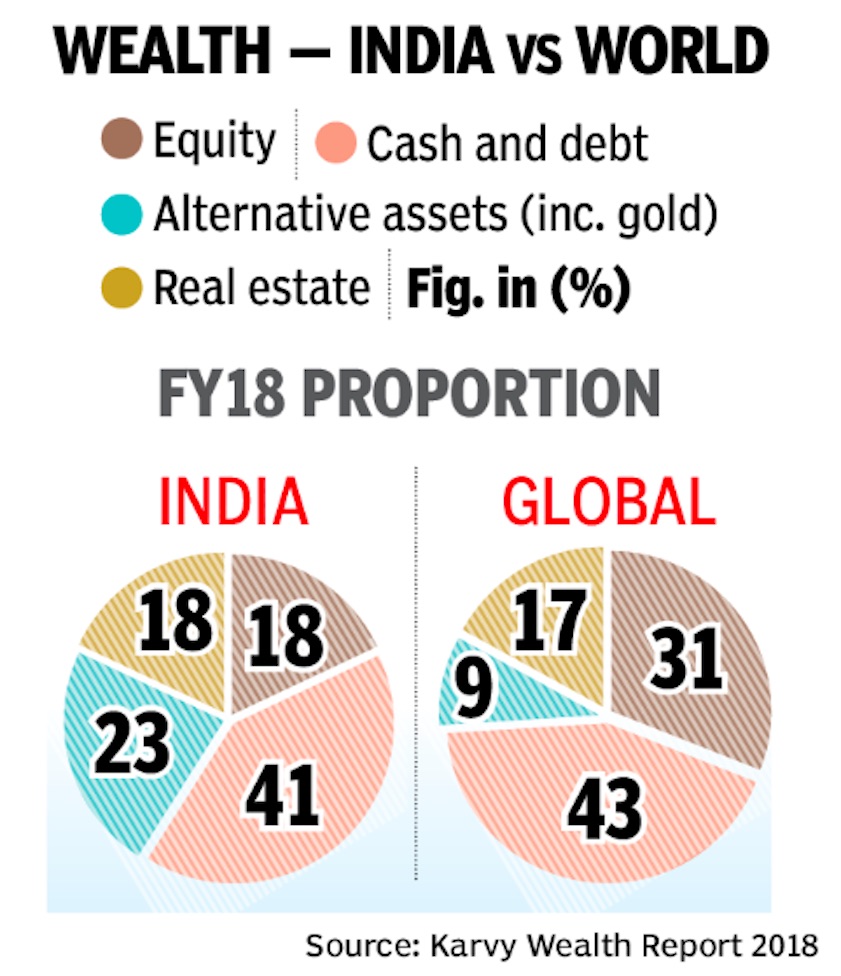
From: January 19, 2019: The Times of India
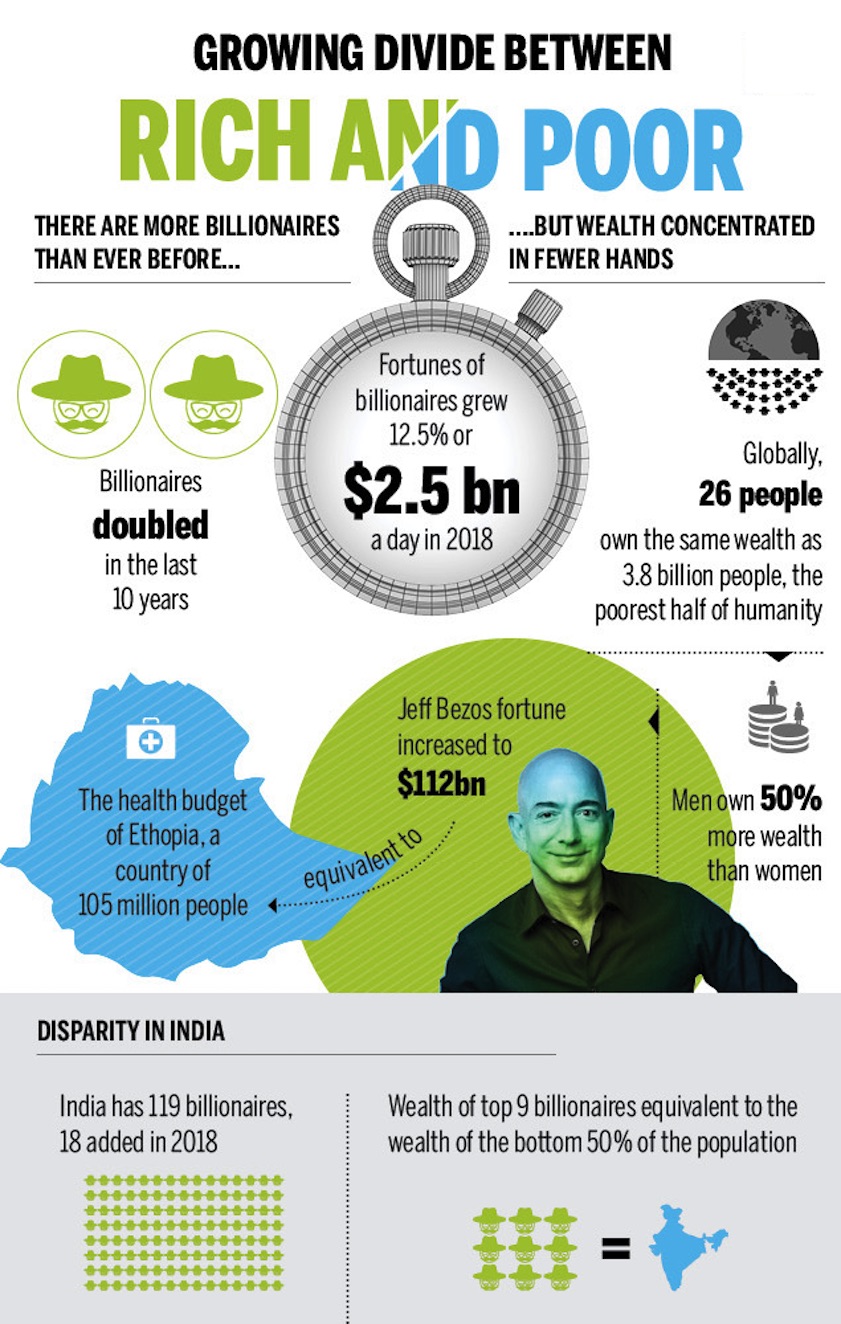
From: India's richest 1% get richer by 39% in 2018; just 3% rise for bottom-half: Oxfam, January 23, 2019: The Times of India
In 2018, individual wealth, financial as well as physical, grew 14%. However, contrary to belief, its financial assets that grew faster than last year. The proportion of financial assets increased to 60% in 2018 as compared to 58% in 2017, according to Karvy Private Wealth’s India Wealth Report.
Indian billionaires saw their fortunes swell by Rs 2,200 crore a day last year, with the top 1 per cent of the country's richest getting richer by 39 per cent as against just 3 per cent increase in wealth for the bottom half of the population, an Oxfam study said.
Globally, billionaires' fortunes rose by 12 per cent or $2.5 billion a day in 2018, whereas the poorest half of the world's population saw their wealth decline by 11 per cent, the international rights group said in its annual study released before the start of the five-day World Economic Forum (WEF) Annual Meeting in this Swiss ski resort town.
Oxfam further said that 13.6 crore Indians, who make up the poorest 10 per cent of the country, continued to remain in debt since 2004.
Asking the political and business leaders who have gathered in Davos for the annual jamboree of the rich and powerful of the world to take urgent steps to tackle the growing rich-poor divide, Oxfam said this increasing inequality is undermining the fight against poverty, damaging economies and fuelling public anger across the globe.
Oxfam International Executive Director Winnie Byanyima, one of the key participants at the WEF summit, said it is "morally outrageous" that a few wealthy individuals are amassing a growing share of India's wealth, while the poor are struggling to eat their next meal or pay for their child's medicines.
"If this obscene inequality between the top 1 per cent and the rest of India continues then it will lead to a complete collapse of the social and democratic structure of this country," she added.
Noting that wealth is becoming even more concentrated, Oxfam said 26 people now own the same as the 3.8 billion people who make up the poorest half of humanity, down from 44 people last year.
The world's richest man Jeff Bezos, the founder of Amazon, saw his fortune increase to $112 billion and just 1 per cent of his fortune is equivalent to the whole health budget for Ethiopia, a country of 115 million people.
"India's top 10 per cent of the population holds 77.4 per cent of the total national wealth. The contrast is even sharper for the top 1 per cent that holds 51.53 per cent of the national wealth.
"The bottom 60 per cent, the majority of the population, own merely 4.8 per cent of the national wealth. The wealth of top 9 billionaires is equivalent to the wealth of the bottom 50 per cent of the population," Oxfam said while noting that the high level of wealth disparity subverts democracy.
Between 2018 and 2022, India is estimated to produce 70 new dollar millionaires every day, Oxfam said.
"It (the survey) reveals how governments are exacerbating inequality by underfunding public services, such as healthcare and education, on the one hand, while under-taxing corporations and the wealthy, and failing to clamp down on tax dodging on the other," Oxfam India CEO Amitabh Behar said.
The survey also shows that women and girls are hardest hit by rising economic inequality, he added.
"The size of one's bank account should not dictate how many years your children spend in school, or how long you live — yet this is the reality in too many countries across the globe. While corporations and the super-rich enjoy low tax bills, millions of girls are denied a decent education and women are dying for lack of maternity care," Byanyima said.
According to the Oxfam report, India added 18 new billionaires last year, raising the total number of billionaires to 119, while their wealth crossed the USD 400 billion (Rs 28 lakh crore) mark for the first time.
It rose from $325.5 billion in 2017 to $440.1 billion in 2018, making it the single largest annual increase since the 2008 global financial crisis.
Oxfam further said getting India's richest 1 per cent pay just 0.5 per cent extra tax on their wealth could raise enough money enough to increase the government spending on health by 50 per cent.
It said the combined revenue and capital expenditure of the Centre and states for medical, public health, sanitation and water supply is Rs 2,08,166 crore, which is less than the country' richest man Mukesh Ambani's wealth of Rs 2.8 lakh crore.
Globally, Oxfam said the tax rates for wealthy individuals and corporations have been cut dramatically.
While billionaire wealth soars, public services are suffering from chronic underfunding or being outsourced to private companies that exclude the poorest people, Oxfam said.
The rights group said in many countries including India, a decent education or quality healthcare has become a luxury only the rich can afford.
"Children from poor families in India are three times more likely to die before their first birthday than children from rich families," it added.
Oxfam said its calculations are based on the latest comprehensive data sources available publicly, including from the Credit Suisse Wealth Databook and the annual Forbes Billionaires List.
2019
"Asian Rich List": Hinduja Group tops
March 23, 2019: The Times of India
Leading London-based NRI industrial tycoons, the Hinduja family has topped the 'Asian Rich List' for the sixth successive year in 2019 with an estimated net worth of 25.2 billion pounds, an increase of over 3 billion pounds over the previous year.
According to the 'Asian Rich List 2019' released at the Asian Business Awards here on Friday night, steel magnates Lakshmi Mittal and his son Aditya Mittal remained in second place, with a total wealth of 11.2 billion pounds, down 2.8 billion pounds from last year.
India's High Commissioner to the UK Ruchi Ghanashyam released the list which is a compilation of the 101 wealthiest Asians in Britain, highlighting exceptional entrepreneurial achievement over the last 12 months.
S P Lohia (Petrochemicals) took the third place with 5.8 billion pounds.
The entries of the 'Asian Rich List 2019' have a combined wealth of more than 85.2 billion pounds.
The figure is increasing year on year and this year's overall wealth increases by over 5 billion pounds.
The list features seven new entries, including hotelier Joginder Sanger and his son Girish Sanger who enter at number 40 on the list with an estimated value of 300 million pounds.
Leading NRI entrepreneur Lord Swraj Paul and family are 17th in the list with a net worth 900 million pounds- an increase of 100 million pounds over the previous year.
Shailesh Solanki, executive editor of Asian Marketing Group (AMG) publisher of the Rich List said, "The Asian Rich List is carefully compiled by a team of experts and it is the definitive guide to Asian wealth in Britain."
Gopichand Hinduja, co-chairman of the Hinduja Group said "our existing portfolio of companies is all in the sunrise sectors. Our focus is on banking and financial services, healthcare and of course, philanthropy."
In London, the Hindujas are continuing with the conversion of the Old War Office, on which they have a 250-year lease, into a luxury residential and 125-room Raffles Hotel complex.
He said in India, there has been investment worth Rs 1,000 crore (108 million pounds) in car and bus manufacturers Ashok Leyland, where Gopi's younger son, Dheeraj Hinduja, is chairman.
It recently inaugurated a cutting edge electric vehicle facility in its Ennore plant at Chennai. Ashok Leyland is introducing battery-operated technology in its buses.
Gopi said "All our businesses are going through a digital transformation journey."
For example, "Hinduja Global Solutions (HGS) is ramping up its headcount in the US, with plans to add 600 more people by June 2019 by setting up a new centre in Florida."
HGS, rebranded from HTMT Global, has a presence in 12 countries including the Philippines, the US, the UK, Canada, France, Germany, Italy, the Netherlands, Mauritius, the UAE and Jamaica. In India, it has 68 "delivery centres" in Bengaluru, Chennai, Hyderabad and Mumbai as well as in growing cities such as Mysore, Nagercoil, Durgapur, Siliguri and Guntur.
The Hinduja National Power Corp recently acquired Kiran Energy Solar Power for Rs 1,000 crore (108 million) to "augment our presence in the renewable and alternative energy space," Gopi explained.
In healthcare, special attention is being devoted to spreading "cancer awareness". In Mumbai, the PD Hinduja Hospital was involved in organising "the cancer is curable ride" on World Cancer Day on February 4.
2019: Mukesh Ambani among world’s 6 oil elites
Bloomberg, Nov 20, 2019: The Times of India
Key Highlights
The Indian conglomerate’s market capitalisation was about $133 billion, overtaking the British energy giant’s $132 billion value at the close of trading
RIL’s shares have increased this year after its billionaire owner in August announced plans to cut the company’s net debt to zero in 18 months
NEW DELHI: Reliance Industries Ltd, run by Asia’s richest man Mukesh Ambani, has eclipsed BP Plc to break into an elite club of energy supermajors.
The Indian conglomerate’s market capitalisation was about $133 billion, overtaking the British energy giant’s $132 billion value at the close of trading on Tuesday. Reliance’s shares have increased at three times the pace of India’s benchmark index this year after its billionaire owner in August announced plans to cut the company’s net debt to zero in 18 months through measures including a stake sale in the oil-to-chemicals business to Saudi Aramco.
The surge in shares gives Ambani a net worth of $56 billion, making him Asia’s richest person, above Alibaba Group’s Jack Ma, according to the Bloomberg Billionaires Index. Reliance’s market value briefly surpassed BP for the first time at the end of last month, and it has now regained the lead over the British company after its shares ended at a record high in Mumbai. It also narrowing the gap with PetroChina Co, currently Asia’s biggest oil company by market cap.
Reliance has increased 35% this year, compared with BP’s 1.2% gain as it works on cutting high debt levels. Oil companies have struggled because of swings in crude prices and as uncertainty persists over future energy demand.
Reliance, meanwhile, has benefited in a number of ways. It operates the world’s biggest oil-refining complex in western India, which can process low-quality crude and turn it into higher-grade fuels, partly protecting it from volatility in prices.
Telecom, retail
While Reliance gets two-third of its revenue from energy, Ambani has also made massive investments in telecom and digital services as he looks to benefit from growing demand in the world’s second-biggest market for mobile phone users. He has also expanded the company’s retail business to take on Amazon.com Inc and Walmart Inc.
The telecom unit, Reliance Jio, which claims to be world’s largest mobile data network, was also bolstered by a recent blow to India’s wireless carriers that left Ambani’s company largely unscathed.
Reliance is now the world’s sixth-largest oil company, with Exxon Mobil Corp topping the list with a market value of about $290 billion. Aramco, formally known as Saudi Arabian Oil Co, is planning an initial public offering with a valuation target of between $1.6 trillion and $1.7 trillion, which would make it the world’s biggest.
2020
Changes because of Covid: till June
June 24, 2020: The Times of India
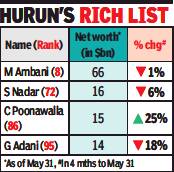
From: June 24, 2020: The Times of India
Billionaires have been quick to recoup their losses in the aftermath of the Covid-19 crisis. Of the four Indian billionaires who are among the world’s top 100, Mukesh Ambani saw a V-shaped recovery in his wealth, losing 19% in the initial weeks and regaining 18% in dollar terms.
Vaccine king Cyrus Poonawalla was one of the fastest gainers in the world with his net worth rising 25% to $15 billion, making it into the top 100. The Gautam Adani family and Shiv Nadar of HCL, the remaining two in the top 100, saw their wealth decline by 18% and 6% respectively.
China-headquartered Hurun, which composes a world rich list every year, has published a special report on wealth impact four months after the Covid-19 outbreak. According to the report, the world’s top 100 billionaires clawed back almost all their initial losses in the second two months of the pandemic, after losing the equivalent of Rs 30.8 lakh crore in the first two months. As a result, their wealth was down only 2% in four months.
“Having finished the ‘world’s fastest billion-dollar fund-raise’ in the technology sector, Mukesh Ambani gained all the wealth he lost before the Janata Curfew. India could be playing a very impactful role in fighting coronavirus through Dr Cyrus Poonawalla-run Serum Institute of India. Since last four months, Poonawalla has gained almost 25% to register a wealth of Rs 1,13,300 crore. Foreign investors’ belief in India’s telecom potential and leadership in biotech were displayed during the four months after Covid-19,” said Hurun India MD and chief researcher Anas Rahman Junaid.
The biggest winner was Jeff Bezos of Amazon, who saw his wealth shoot up $20 billion to $160 billion.
2023
See graphic:
World's richest; India's richest, 2022-23
See also…
Rich List: India <> Rich List: India, 2014: Forbes <>Rich List: India, 2014: Hurun <>Rich List: India, 2015: Forbes <> Rich List: India, 2015: Hurun <>Rich list, India: 2016 <> Rich List: India, 2016: Forbes <> Rich List: India, 2017 <> Rich List: India, 2017: Hurun<> Rich list, India: 2018<> Rich list, India: 2019<> Rich List, India: 2020<> Rich List, India: 2021<> Rich List, India: 2022
Rich list of film artistes: India
…and also
Rich List: Nepal<> Celebrity List: India<> Indian money in HSBC, Switzerland <> Private lives of famous Indians
